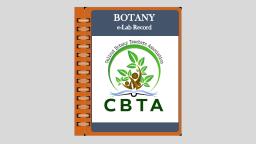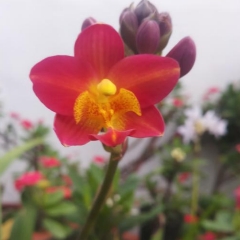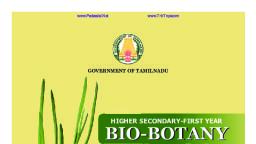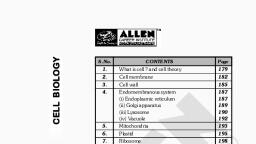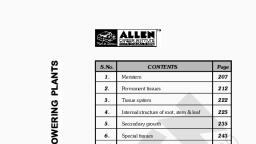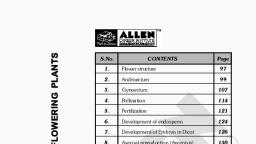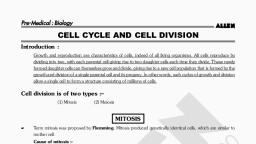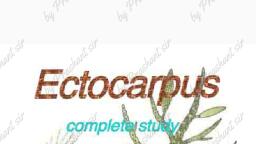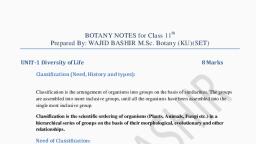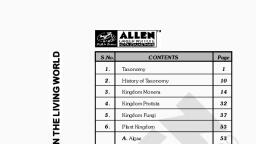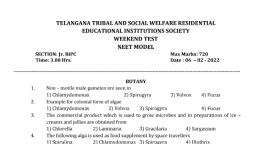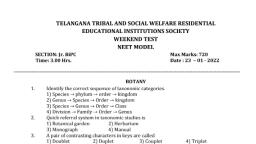Page 1 :
MAHATHMA JYOTHIBHA PHULE TELANGANA BACKWARD CLASSES WELFARE, RESIDENTIAL EDUCATIONAL INSTITUTIONS SOCIETY - HYDERABAD, , Intermediate – first year, Botany – study material, , Intermediate First Year - Botany, , Page 1
Page 2 :
CONTENTS, Unit – I Diversity in the living world, Chapter – 1 The Living world, Chapter – 2 Biological Classification, Chapter – 3 Science of plants - Botany, Chapter – 4 Plant kingdom, Unit – II Structural organization in plants – Morphology, Chapter – 5 Morphology of flowering plants, Unit – III Reproduction in plants, Chapter – 6 Modes of Reproduction, Chapter – 7 Sexual reproduction in flowering plants, Unit – IV Plant systematics, Chapter – 8 Taxonomy of angiosperms., Unit – V Cell structure and functions, Chapter – 9 The Unit of life, Chapter – 10 Biomolecules, Chapter - 11 Cell cycle and cell division, Unit – VI Structural organization of plants, Chapter – 12 Histology and anatomy of flowering plants, Unit – VI Plant Ecology, Chapter – 13 Ecological adaptations, Succession and ecological services., , ****, , BOARD OF INTERMEDIATE EDUCATION – TELANGANA, Intermediate First Year - Botany, , Page 2
Page 3 :
Intermediate I Year Syllabus – BOTANY, UNIT-I: DIVERSITY IN THE LIVING WORLD, Chapter 1: The living world what is living?, Diversity in the living world; Taxonomic categories and taxonomical aids., Chapter 2: Biological Classification., Five kingdom classification - Monera, Protista, Fungi, Plantae and Animalia, Three domains of, life (six kingdom classification), Viruses, Viroids, Prions & Lichens., Chapter 3: Science of plants – Botany., Origin, Development, Scope of Botany and Branches of Botany., Chapter 4: Plant Kingdom., Salient features, classification and alternation of generations of the plants of the following, groups – Algae, Bryophytes, Pteridophytes, Gymnosperms and Angiosperms., , UNIT - II: STRUCTURAL ORGANISATION IN PLANTS- MORPHOLOGY, Chapter 5: Morphology of flowering Plants., Parts of a typical Angiospermic plant; Vegetative morphology and modifications- Root, Stem, and Leaf- types; Venation, Phyllotaxy. Reproductive: Inflorescence – Racemose, Cymose and, special types (in brief). Flower: Parts of a flower and their detailed description; Aestivation,, Placentation. Fruits: Types- True, False and parthenocarpic fruits., , UNIT-III: REPRODUCTION IN PLANTS, Chapter 6: Modes of Reproduction., Asexual reproduction, binary fission, Sporulation, budding, fragmentation, vegetative, propagation in plants, Sexual reproduction in brief, Overview of angiosperm life cycle., Chapter 7: Sexual Reproduction in Flowering Plants., Stamen, microsporangium, pollen grain. Pistil, megasporangium (ovule) and embryo sac;, Development of male and female gametophytes. Pollination – Types, agents, out breeding, devices and Pollen – Pistil interaction. Double Fertilization; Post fertilisation events:, Development of endosperm and embryo; development of seed, Structure of Dicotyledonous, and Monocotyledonous seeds, Significance of fruit and seed. Special modes – Apomixis,, parthenocarpy, polyembryony., UNIT-IV: PLANT SYSTEMATICS, Chapter 8 : Taxonomy of angiosperms Introduction. Types of Systems of classification (In, brief). Semi- Technical description of a typical flowering plant Description of Families:, Fabaceae, Solanaceae and Liliaceae., Intermediate First Year - Botany, , Page 3
Page 4 :
UNIT-V: CELL STRUCTURE AND FUNCTION, Chapter 9: Cell – The Unit of Life., Cell- Cell theory and cell as the basic unit of life- overview of the cell. Prokaryotic cells,, Ultra Structure of Plant cell (structure in detail and functions in brief), Cell membrane, Cell, wall, Cell organelles: 3 Endoplasmic reticulum, Mitochondria, Plastids, Ribosomes, Golgi, bodies, Vacuoles, Lysosomes, Microbodies, Centrosome and Centriole, Cilia, Flagella,, Cytoskeleton and Nucleus. Chromosomes: Number, structural organization; Nucleosome, Chapter 10: Biomolecules., Structure and function of Proteins, Carbohydrates, Lipids and Nucleic acids., Chapter 11: Cell cycle and Cell Division., Cell cycle, Mitosis, Meiosis - significance., , UNIT-VI: INTERNAL ORGANISATION OF PLANTS, Chapter 12: Histology and Anatomy of Flowering Plants., Tissues - Types structure and functions: Meristematic; Permanent tissues - Simple and, Complex tissues. Tissue systems - Types, structure and function: Epidermal, Ground and, Vascular tissue systems. Anatomy of Dicotyledonous and Monocotyledonous plants - Root,, Stem and Leaf. Secondary growth in Dicot stem and Dicot root. UNIT-, , VII: PLANT ECOLOGY, Chapter 13: Ecological Adaptations, Succession and Ecological Services., Introduction. Plant communities and Ecological adaptations: Hydrophytes, Mesophytes and, Xerophytes. Plant succession. Ecological services – Carbon fixation, Oxygen release and, pollination., , // **** //, , Unit – I Diversity in the living world, Chapter – 1 The Living world, VERY SHORT ANSWER QUESTIONS (2 MARKS), Intermediate First Year - Botany, , Page 4
Page 5 :
01. What does ICBN stand for?, A. ICBN stands for international code for botanical nomenclature., 02. What is Flora?, A. Flora is the actual account of habitat, distribution and systematic listing of plants of a, given area., 03. Define metabolism. What is the difference between anabolism and catabolism?, A. 1. Metabolism refers to the sum of total of all chemical reactions occurring in the body, of an organism., 2. The constructive metabolic process in which complex molecules are formed from, simple molecules is called Anabolism., 3. The destructive metabolic process in which complex molecules are broken down into, simple molecules is called Catabolism., 04. Which is the Largest Botanical Garden in the world? Name a few well known, Botanical gardens in India., A. 1. Royal botanical garden at Kew (England) is the largest botanical garden in the world., 2. Indian Botanical Gardens Howrah and National Botanical Research Institute, Lucknow, are called well known botanical gardens in India., 05. Define the terms couplet and lead in taxonomic key., A. 1. In taxonomic key the contrasting characters of a pair is called couplet. It represents, the choice made between two opposite options., 2. Each statement in the key is called lead., 06. What is meant by manuals and monographs?, A. 1. Manuals are recorded descriptions useful in providing information for identification of, names of species found in an area., 2. Monographs contain information on any one taxon., 07. What is systematics?, A: The study of different kinds of organisms, their diversities and also the relationship, among them is called systematics., 08. What is the basic unit of Classification? Define it., A. 1. Species is the basic unit of classification., 2. Species can be defined as a group of individual organisms with fundamental, similarities., 09. Give the scientific name of mango. Identify the generic name and specific epithet., A. 1. The scientific name of mango is Mangifera indica., 2., Mangifera is generic name and indica is specific epithet., Intermediate First Year - Botany, , Page 5
Page 6 :
10., A:, , Why are living organisms classified?, It is impossible to study all living organisms without any means., Classification is the mean to make possible the study of all living organisms. So the, organisms classified., , 11., , What is growth? What is the difference between the growth in living organisms and, growth in non-living objects?, Increase in mass and increase in number of individuals is growth. In living organisms, growth is from inside., In non-living organisms it is by accumulation of material on the surface., , A:, , SHORT ANSWER QUESTIONS (4 MARKS), , 01. What is meant by identification and nomenclature? How is the key help in the, identification and classification of an organism?, o We know the plants and animals in our locality by their local names., o These local names vary from location to location within a country. Due to this a single, name may be used for different plants or a single plant may have different names., o To eliminate this confusion there is a need to standardize the naming of living, organisms such that a particular organism is known by the same name all over the, world., o This process is called nomenclature or naming., o Nomenclature is providing a single valid scientific name to an identified organism., o Nomenclature or naming is possible only when the organism is described correctly, and accurately identified. This is identification., o Identification is to determine whether the collected organism is entirely new or, already known., o In plants this identification is done by directly comparing the characters with an, authenticated specimen or indirectly with the help of keys., 02., o, o, o, o, o, o, , What are taxonomical aids? Give the importance of herbaria and museums?, For accurate identification and classification of an organism or plant require intensive, laboratory and field studies., Any device that assists or help in identification and classification of the plant is called, Taxonomical aids., Such taxonomic aids are Herbaria, Museums and Botanical Gardens., For this, the collection of actual specimen of plants or animal species is essential., This is the prime source of taxonomic studies. Keys are contrasting characters, expressed in pairs called couplet. This results in accepting, To determine its identification, the specimen is directly compared with an authentic, specimen already described and identified earlier., , Intermediate First Year - Botany, , Page 6
Page 7 :
o, , o, o, , o, , 04., o, o, o, o, o, o, o, o, , 05., o, o, o, o, o, o, , Herbarium is a store house of collected plant specimens that are dried, pressed and, preserved on sheets. Further, these sheets are arranged according to a universally, accepted system of classification., These specimens, along with their descriptions on herbarium sheets, become a store, house or repository for future use., The herbarium sheets also carry a label providing information about date and place, of collection, English, local and botanical names, family, collector’s name, etc., Herbaria serve as quick referral systems in taxonomical studies., Museums have collections of preserved plant and animal specimens for study and, reference. Specimens are preserved in the containers or jars in preservative, solutions. Plant and animal specimens may also be preserved as dry specimens., Museums like herbaria serve as referral systems in taxonomical studies., How are botanical gardens are useful in conserving biodiversity? Define the terms, Flora, manuals, monographs and catalogues?, Botanical Gardens are specialised gardens that have collections of living plants for, reference., Plant species in these gardens are grown for identification purposes and each plant is, labelled indicating its botanical/scientific name and its family., The famous botanical gardens are at Kew (England), Indian Botanical Garden, Howrah, (India) and at National Botanical Research Institute, Lucknow (India)., As many different kinds and groups of plants are grown here in protected, environment these gardens conserve biodiversity., Flora contains the actual account of habitat and distribution of plants of a given area., These provide the index to the plant species found in a particular area., Manuals are useful in providing information for identification of names of species, found in an area., Monographs contain information on any one taxon. Catalogues are compilations of, plant information including names and classifications., Flora, manuals, monographs and catalogues are means of recording descriptions., They help in correct identification., Explain Binomial Nomenclature., 1. The system of providing a name with two components is called binomial, nomenclature., 2. Every plant should have only one correct scientific name., 3. Every scientific plant name has two components. They are generic name and, specific epithet., 4. Scientific name should be in Latin or Latin derivatives., 5. Both the words, when hand written they must be underlined or printed in italics to, indicate their Latin origin., 6. The generic name must be in the noun form and always begins with capital letter., The specific name will be in the adjective form and starts with small letter. For, , Intermediate First Year - Botany, , Page 7
Page 8 :
o, o, , example Solanum tuberosum is the name of potato plant in which ‘Solanum’ is the, genus and ‘tuberosum’ is the species., 7. The author`s name may be given in abbreviated form at the end of the scientific, name., For example: Mangifera indica Linn. It indicates that the species was first described, by Linnaeus., , ****, , Chapter – 2 Biological Classification, VERY SHORT ANSWER QUESTIONS (2 MARKS), Intermediate First Year - Botany, , Page 8
Page 9 :
01. What is the nature of cell walls in diatoms?, A: In diatoms the cell walls form two thin overlapping shells. The upper one is called, epitheca and the lower one is called hypotheca. They both fit together as in a soap, box., The walls embedded with silica., 02., , , , , , , 03., A. 1., 2., 3., , How are viroids different from viruses?, viruses, It is a nucleoprotein particle., Nuclic acid can be DNA or RNA., A protein coat is present., Viruses are smaller than bacteria but, larger than viroids., Viruses infect all types of organisms, , , , viroids, It is an RNA particle., Viroids are formed only by RNA., A protein coat is absent., Viroids are smaller than viruses., , , , Viroids infect only plants., , , , , , What do the terms Phycobiont & Mycobiont Signify?, The group of algae that live as symbionts in lichens are phycobionts., The group of fungi that live as symbionts in lichens are mycobionts., Algae and fungi in lichens show symbiontic association., , 04. What do the terms “Algal bloom” and “Red Tides” Signify?, Algal Bloom: When the algae (mostly cyanophyceae) in water body have excessive growth, due to the enrichment of excessive nutrients in it, then it is called algal bloom., Red Tides: When the sea appears red due to the rapid multiplication of red dinoflagellates, e.g. Gonyaulax then it is called Red Tides or Red tides in Mediterranean Sea., 05. State two economically important uses of heterotrophic bacteria, A. 1. They help in making curd from milk., 2. They are helpful in nitrogen fixation in roots of leguminous plants., 06., , What is the principle underlying the uses of heterotrophic bacteria in Agricultural, fields for crop improvement?, A:, Cyanobacteria are used in agricultural fields for crop improvement because they help, in nitrogen fixation and make the soil fertile., E.g. Nostoc, Anabaena., 07., A:, 08., , Plants are autotrophic. Name some plants which are partially heterotrophic., Plants which are partially heterotrophic are insectivorous plants and parasitites., Bladderwort and venus flytrap are examples of insectivorous plants. Cuscuta is, example for parasites., Who proposed five kingdom classification? Howmany kingdoms of this, classification contain eukaryotes?, A: R.H Whittaker proposed five kingdom classification., Four kingdoms contain eukaryotes; they are protista, fungi, plantae, and animalia., , Intermediate First Year - Botany, , Page 9
Page 10 :
09., A., , Give the main criteria used for classification by whittaker., The main criteria for classification used by whittaker is cell structure, thallus, organization, mode of nutrition, reproduction and phylogenetic relationships., , 10., A. 1., 2., 3., , Name Two (2) diseases caused by Mycoplasmas., Witches broom in plants., Pleuropneumonia in cattle., Mycoplasmal urethritis in humans., , 11., , What are slime moulds? Explain what is meant by plasmodium with reference to, slime moulds., A. Slime moulds are saprophytic protists. Under favourable conditions, slime moulds, aggregate to form plasmodium which may grow and spread several feet., SHORT ANSWER QUESTIONS (4MARKS), 01., 1., 2., 3., 4., , What are the characteristic features of euglenoids?, These are unicellular, flagellated, fresh water organisms found in stagnant water., Cell wall is absent., The body is covered by thin flexible pellicle., They bear two flagella, usually one long and one short., They swim actively by flagella., 5. The anterior part of the cell bears in an invagination consisting of, Cytostome (cell mouth), cytopharynx(gullet) and reservoir., 6. A photosynthetic stigma or eye spot is present in the reservoir., 7. Chloroplast is present. The pigments in it are identical to those present in higher plants, Perform photosynthesis., 8. In the absence of sun light they behave like heterotrophs depending on smaller, organisms for food., 9. Reproduction is by longitudinal binary fission. Palmella stage is found in euglena., 02. Give the salient features and importance of chrysophytes., 1. This group includes diatoms and desmids (golden algae), 2. They are green, microscopic, float in water currents., 3. Most of them are photosynthetic, 4. In diatoms the cell walls form two thin overlapping shells, epitheca and hypotheca, which fit together as soap box., 5. The cell walls are embedded with silica which is indestructible. They pile at the bottom, of the water to form diatomaceous earth., 6. Diatoms are divided into two types based on symmetry., i) Centrale diatoms are radially symmetrical., Intermediate First Year - Botany, , Page 10
Page 11 :
ii) Pinnales are bilaterally symmetrical., 7. Asexual reproduction is by binary fission and sexual reproduction is by the formation, of gametes., Importance: Diatoms are the chief producers in the oceans., The diatomaceous soil is used in polishing, filtration of oils and syrups., 03. Give a brief account of Dinoflagetllates., 1. Dinoflagellates are marine. They appear as yellow, green brown, blue or red depending, upon the pigments present in the cells., 2. Cell wall is made up of cellulose plates., 3. Two flagella are present. One lies longitudinally and other lies, transversely in the furrow between the wall plates., 4. Flagella produce spinning movements., So these are called whirling whips., 5. Nucleus is called Mesokaryon as chromosomes are, condensed without histones., E.g. Nostoc – shows bioluminescence., Gonyaulax – make the sea appear red (red tide), 6. Toxins produced by them may kill fishes., 04., 1., 2., 3., 4., , 5., 6., 7., , Write the role of fungi in our daily life., Mushroom and toad stools are edible fungus., Unicellular fungi like yeast are used to make bread and beer., Fungi like Rhizopus commonly grow on stale bread, pickles, jams, cheese, on moist, food stuff and spoil them. They are called moulds., Fungi cause diseases in plants and animals., e.g. Wheat rust is caused by puccinia., Late blight of potato by phytopthora., Orange rot, red rot in sugarcane are caused by fungus., White spots on mustard leaves are due to parasitic fungus., Some fungi are the source of antibiotics e.g.Penicillium., ****, , Chapter – 3 Science of plants – Botany, VERY SHORT ANSWER QUESTIONS (2MARKS), , 01. Explain how the term botany has emerged?, A: In ancient Greek language, the term bouskein means cattle feed. The bouskein gave, rise to botane from which the term ‘Botany’ is derived., , Intermediate First Year - Botany, , Page 11
Page 12 :
02. Name the books written by Parasara and mention the important aspects discussed in, those books., A. ‘’Krishi parasharam ” and “ Vrikshayurveda “ were the books written by parasara. In, Krishi parasharam he discussed about agriculture and weeds. In Vrikshayurveda he, described different types of forests, external characters of plants including medicinal, plants., 03. Who is popularly known as Father of Botany? What was the book written by him?, A. 1., Theophrastus is popularly known as “Father of Botany”., 2., ‘Historia plantarum’ was the book written by him., 04. Who are herbalists? What are the books written by them?, A. 1. Herbalists are botanists of Renaissance period who identified and described, medicinal plants living in natural surroundings., 2. The books written by them are called herbals., 05. What was the contribution of Carolus von Linnaeus for the development of plant, taxonomy?, A: Carolus von Linnaeus popularized binomial nomenclateure. He also proposed the sexual, system of classification., 06. Why is Mendel considered as the Father of Genetics?, A. 1. Mendel introduced the law of inheritance based on his hybridization experiments on, pea plant., 2. He marked the beginning of genetics and became popular as the father of genetics., 07. Who discovered the Cell and what was the book written by him?, A. 1., Robert Hooke discovered the cell., 2., Micrographia was the book written by him., 08. What is Palaeobotany? What is its use?, A. 1., Palaeobotany is the study of fossil plants., 2., It helps in understanding the course of evolution in plants., 09. Name the branches of botany which deals with the chlorophyllous autotrophic, thallophytes and non-chlorophyllous heterotrophic thallophytes., A: The study of chlorophyllous autotrophic thallophytes (Algae) is Phycology., The study of non-chlorophyllous heterotrophic thallophytes (Fungi) is Mycology., 10. What are the groups of plants that live as symbionts in Lichens? Name the study of, Lichens., A. 1. Algal members and fungal members are the groups of plants that live as symbionts in, lichens., 2., The study of lichens is called Lichenology., 11. Which group of plants is called as Vascular Cryptogams? Name the branch of Botany, which deals with them?, Intermediate First Year - Botany, , Page 12
Page 13 :
A. 1., Pteridophytes are called vascular cryptogams., 2. The branch which deals with pteridophytes is called pteridology., 12. Which group of plants is called as amphibians of the plant kingdom? Name the, branch of Botany which deals with them?, A. 1., Bryophytes are called amphibians of plant kingdom., 2. The branch deals with bryophytes are called Bryology., SHORT ANSWER QUESTIONS (4 MARKS), , 01. Explain in brief the scope of botany in relation to agriculture and horticulture and, medicine?, 1. Agriculture, horticulture and medicine have recorded great progress through, experiments in hybridization and genetic engineering., 2. New techniques of plant breeding are useful to develop hybrid varieties in crop, plants like rice, wheat, sugarcane maize etc., 3. Antibiotics like penicillin are obtained from fungi., 4. The role of minerals in plant nutrition and the importance of hormones in plant, growth helped in the development of agriculture., 5. There are many plants like Cinchona, Neem, Datura, Digitalis, Rauwolfia, Withania,, Ocimum, Belladona, Aloe etc., 6. Using genetic engineering technique, cloned DNAs are produced which prepare, hormones like Insulin, Interferon and vaccines., , ****, , Chapter – 4 Plant kingdom, VERY SHORT ANSWER QUESTIONS (2 MARKS), , 01. What is the basis of classification of Algae?, A: Pigments and types of stored food., 02. When and where does reduction division takes place in the life cycle of a Liverwort,, a moss, a fern, a gymnosperm and an angiosperm?, Intermediate First Year - Botany, , Page 13
Page 14 :
A: Liverwort --- sporogenous tissue inside the capsule., Mosses --- sporogenous tissue inside the capsule., Fern --- sporogenous tissue inside the sporangium., Gymnosperm – sporogenous tissue of pollen sac and in the archesporial cell of nucellus., Angiosperm -- sporogenous tissue of pollen sac and in the archesporial cell of nucellus., 03. Differentiate between syngamy and triple fusion., A: Syngamy: One of the male gamete fuses with the egg cell and forms a diploid zygote., This fusion is called Syngamy or fertilization. This is also called true or real Fertilization., Triple Fusion: The second male gamete fuse with the secondary nucleus (Formed by the, fusion of two polar nuclei) of the embryo sac. This result in the formation of a triploid, Primary endosperm nucleus (PEN) is called Triple Fusion., 04. Differentiate between antheridium and archegonium ?, A. 1. The antheridium is a male sex organ whereas archegonium is female sex organ., 2. Antheridium produces many antherozoids/sperms. Archegonium produces egg cell., 05. What are the two stages found in the gametophyte of mosses? Mention the, structures from which these two stages develop?, A: The juvenile stage protonema and adult leafy stage gametophore., Protonema directly develops from spore., Gametophore develops from protonema as lateral adventitious buds., 06., A., , Name the stored food materials found in Phaeophyceae and Rhodophyceae., The stored food materials found in phaeophyceae are laminarin or mannitol. The, stored food material found in Rhodophyceae is Floridian starch., , 07., A., , Name the pigments responsible for brown colour of Phaeophyceae and red colour, of Rhodophyceae., The brown colour of phaeophyceae depends upon the amount of xanthophyll, pigments, fucoxanthin present in it. The red colour of rhodophyceae is due to red, pigment r – phycoerythrin., , 08., A:, , Name different methods of vegetative reproduction in Bryophytes?, Fragmentation, gemmae and budding., , 09. Name the integumented megasporangium found in Gymnosperms. How many, female gametophytes are generally formed inside the megasporangium?, A: Ovule. One., 10. Name the gymnosperms which contain mycorrhiza and coralloid roots respectively., A. 1., Pinus contains mycorrhizal roots., 2., Cycas contains corolloid roots., 11. Mention the ploidy of any four of the following?, Intermediate First Year - Botany, , Page 14
Page 15 :
a. Protonemal cell of a moss., b. Primary endosperm nucleus in a dicot., c. Leaf cell of a moss., d. Prothallus of a fern., e. Gemma cell in Marchantia., f. Meristem cell of monocot., g. Ovum of a liverwort., h. Zygote of a fern., A: a. Protonemal cell of a moss --- Haploid., b. Primary endosperm nucleus in a dicot --- Triploid., c. Leaf cell of a moss --- Haploid., d. Prothallus of a fern --- Haploid., e. Gemma cell in Marchantia --- Haploid., f. Meristem cell of monocot ---Diploid., g. Ovum of a liverwort ---- Haploid., h. Zygote of a fern --- Diploid., 12. Name the four classes of pteridophytes with one example each., A: Psilopsida : Psilotum., Lycopsida : Lycopodium., Sphenopsida : Equisetum., Pteropsida : Pteris., 13. What are the first organisms to colonise rocks? Give the generic name of the moss, which provides peat., A. Mosses and lichens are first organisms to colonise rocks. Species of sphagnum, a moss,, provides peat., 14. Mention the fern characters found in cycas., A. 1. Young leaves exhibit circinate vernation., 2. Presence of ramenta., 3. Male gametes are multiciliated., 4. Archegonia are present in the female gametophyte., , 15. Why are bryophytes called the amphibians of the plant kingdom?, A. Bryophytes are called amphibians of the plant kingdom because these plants live in, moist soil and are dependent on water for sexual reproduction., 16. Name an Alga which shows?, a) Haplo-diplontic and, b) Diplontic types of life cycles., A: a) Haplo-diplontic --- Ectocarpus, Laminaria, b) Diplontic --- Fucus, Intermediate First Year - Botany, , Page 15
Page 16 :
17. Give an example for unicellular, colonial and filamentous algae., A: Unicellular algae: Chlamydomonas., Colonial, : Volvox., Filamentous, : Spirogyra., SHORT ANSWER QUESTIONS (4 MARKS), , 01. Diffferentiate between red algae and brown algae, Red algae, Brown Algae, Members of rhodophyceae are, Members of phaeophyceae are, commonly called red algae, commonly called brown algae, They possess chlorophyll a,d and, They possess chlorophyll a,c, phycoerythrin., carotenoids, and xanthophylls., Red colour is due to phycoerythrin, Brown colour is due to xanthophyll, pigment., pigment., Reserve food materials in the form of, Reserve food materials in the form of, Floridian starch., mannitol or laminarin., Their cell walls are composed of, Their cell walls are composed of, cellulose, pectin and phycocolloids., cellulose and algin., Flagella are absent, Two flagella are present., E.g. Polysiphonia, Gelidium., E.g. Ectocarpus, fucus, 02., A:, , 03., , What is meant by homosporous and hetero sporous pteridophytes? Give two, examples., The plant which produce only one kind of spores are called homosporous, E.g. Psilotum, Lycopodium., The plants which produce two kinds of spores, macrospores or megaspores and, microspores are called heterosporous, E.g. Selaginella, Salvinia., Diffferentiate between liverworts and mosses, Liverworts, , Intermediate First Year - Botany, , Mosses, , Page 16
Page 17 :
, , , , , , , , , They have a thallus-like dorsiventrally, flattened body., Rhizoids unicellular, Sporangium is differentiated into foot,, seta and capsule. In some cases foot, and seta may be present., Sporangium does not synthesise its, food., Elaters in the capsule help in spore, dispersal., Columella is absent., Protonema and gametophores are, absent., , , , , , , , , , These are differentiated into stem-like, leaf-like structures., Rhizoids are multicellular and, branched., Sporangium is differentiated into foot,, seta and capsule., Sporangium synthesise its own food., Peristomial teeth help in spore, dispersal., Columella is present., Gametophyte has two stages, i) protonema ii) Gametophore, , 04. What is heterospory? Briefly comment on its significance. Give two examples., A: Producing two types of spores is called heterospory :, i) Microspores ii) Megaspores, Significance:, 1. In heterosporous plants, the megaspores and microspores germinate and give rise to, female and male gametophyte respectively., 2. Male gametes are transferred to the egg of female archegonium., 3. The female gametophyte retain on the parent sporophyte for variable period., 4. The development of zygotes into young embryos takes place within the female, gametophytes., 5. This event is a precursor to the seed habit. It is considered as an important step in, evolution., e.g. Selaginella and Salvinia., 05. Write a note on economic importance of algae and bryophytes., A: Economic importance of Algae:, 1. About 50% of carbon fixation is done by algae by photosynthesis and is released into, environment., 2. Algae are primary producers for all aquatic animals in food cycle., 3. Many species of porphyra, Laminaria and sargasam are among the 70 species of, marine algae used as food., 4. Brown algae and Red algae produce large amounts of hydrocolloids, algin and, carrageen which are used commercially., 5. Agar obtained from Gelidium and Gracilaria is used to grow microbes and in, preparation of Ice creams and jellies., Intermediate First Year - Botany, , Page 17
Page 18 :
6., 7., , Iodine is extracted from kelps like laminaria., Chlorella and spirullina are unicellular algae used as food supplements even by space, travellers., Economic Importance of Bryophytes:, 1. Mosses provide food for herbaceous mammals, birds and other animals., 2. Sphagnum provides peat used as a fuel, because of its water holding capacity, they are, used as packing material., 3. Mosses along with lichens are the first organisms to colonise rocks and hence they, have great ecological importance., 4. They decompose rock making it suitable for the growth of higher plants, hence they, play important role in plant succession., 5. Mosses forms dense mats on the soil, they reduce the impact of falling rain and, prevent soil erosion., 06. How would you distinguish Monocots from Dicots?, , , , , , , , , Monocots, Monocot seeds have one cotyledon., Adventitious root system is present., Leaves show parallel venation., Sheathing leaf base is present., Leaves are isobilateral, Secondary growth is absent., , , , , , , , , Dicots, Dicot seeds have two cotyledons., Tap root system is present., Leaves show reticulate venation., Sheathing leaf base is absent., Leaves are dorsiventral., Secondary growth is takes place., , 07. Give a brief account of protothallus., 1. Haploid spores give rise to gametophytic protothallus in pteridophytes., 2. Protothallus is small, thin, autotrophic thallus like structure., 3. Protothallus grows in cool, damp, shady places as it requires water for fertilization., 4. Protothallus bears sex organs. The male sex organs are called antheridia and female, sex organs are called archegonia., 5. These sex organs are multicellular, jacketed and sessile., 6. Antheridia produce male gametes called antherozoids. Archegonia has egg cell which is, female gamete., 7. Antherozoids require water to reach egg., 8. Zygote develops into embryo within the female gamete. This event is precursor to the, seed habit. It is considered as an important step in evolution., 08. Draw labeled diagram of, a) Female thallus and male thallus of a liverwort, Intermediate First Year - Botany, , Page 18
Page 20 :
Unit – II Structural organization in plants - Morphology, Chapter – 5 Morphology of flowering plants, VERY SHORT ANSWER QUESTIONS (2MARKS), , 01. Differentiate fibrous roots from adventitious roots., A: 1) The roots that emerge from a place other than radical are called adventitious roots, E.g. Climbing roots, velamen roots, respiratory roots., 2) Fibrous roots are adventitious roots which originate from the base of the stem and they, are fibrous in appearance E.g. Monocot plants., 02. Define modification. Mention how root is modified in banyan tree and mangrove, plants?, A: 1) Permanent change in shape and structure of a plant body in order to perform new, function depending upon environment is called modification., 2) In banyan tree roots are formed from the branches to give additional support, they are, called prop roots are pillar roots., 3) In mangrove plants like rhizophora and Avicinnea, the roots come out of the ground, and grow vertically upwards. Such roots are called pneumatophores or respiratory, roots as they help to get oxygen for respiration., 03. What type of specialized roots are found in epiphytic plants? What is their function?, A. Velamen roots are found in epiphytic plants. They absorb moisture from the, atmosphere., 04. What does the sucker of Chrysanthemum differ from the stolon of jasmine?, A: Sucker of Chrysanthemum is an obliquely upward growing branch of an underground, stem where as stolon of jasmine is an obliquely downward growing branch of an aerial, stem., 05. What is meant by pulvinus leaf base? In members of which angiospermic family do, you find them?, A. The swollen leaf base is called pulvinus leaf base. It is found in leguminaceae family., 06. Define venation. How do dicots differ from monocots with respect to venation?, A: The arrangement of veins and veinlets in the lamina of leaf is termed as venation., Dicots show reticulate venation whereas monocots show parallel venation., 07. How is pinnately compound leaf is different from a palmately compound leaf?, Explain with one example each?, A: In pinnately compound leaf a number of leaflets are present on a common axis called, rachis E.g. Neem., In palmately compound leaf, the leaflets are attached at a common point. I.e. at the tip, of the petiole E.g. Bombax ceiba., Intermediate First Year - Botany, , Page 20
Page 21 :
08. Which organ is modified to trap insects in insectivorous plants? Give two examples, A. “Leaves” are modified to trap insects in insectivorous plants e.g. Nepenthes (Pitcher, plant), Dionea (Venus fly-trap)., 09. Differentiate between racemose and cymose inflorescences., A. In racemose inflorescence, the main axis continuous to grow and the flowers are, arranged in accropetal manner. In cymose inflorescence, the main axis ends in a, flower, so growth is limited. The flowers are arranged in basipetal manner., 10. What is the morphology of cup like structure in Cyathium? In which family it is, found?, A. In cyathium, Involucre of bracts form cup like structure. It is found in Euphorbiaceae, family., 11. What type of inflorescence is found in fig trees? Why the insect Blastophaga does, visits the inflorescence of fig tree?, A. Hypanthodium is found in fig trees. The insect blastophaga visits for pollination and, lays its eggs in the gall flowers., 12. Differentiate actinomorphic from zygomorphic flower., A. When a flower can be divided in to two equal radial halves in any radial plane passing, through the centre is said to be actinomorphic flower.e.g. Hibiscus., When a flower can be divided in to two equal halves only in one particular vertical, plane is said to be zygomorphic flower. E.g. Bean, 13. How do the petals in pea plant are arranged? What is such type of arrangement, called?, A: In pea and bean flowers, there are five petals. The largest petal (Standard) overlaps the, two lateral petals (wings) which in turn overlap the two smallest anterior petals (keel)., This type of aestivation is called descendingly imbricate aestivation. This type of corolla, is called vexillary (Papilionaceous) corolla., 14. What is meant by epipetalous condition? Give an example., A. Stamens attached to the petals is called epipetalous condition e.g. Brinjal, Datura., 15. Differentiate between apocarpous and syncarpous ovary., A. 1. When more than one carpel is present in Gynoecium, and they are free, It is called, apocarpous., 2. When carpels are fused, it is called syncarpous., 16. Define placentation. What type of placentation is found in dianthus?, A. 1. The arrangement of ovules within the ovary is known as placentation., 2. In Dianthus, free central placentation is present., , Intermediate First Year - Botany, , Page 21
Page 22 :
17. What is meant by parthenocarpic fruit? How is it useful?, A. 1. The fruit formed without fertilization of ovary is called partenocarpic fruit., 2. They are without seeds., 18. What type of fruit found in mango? How does it differ from that of coconut?, A. The type of fruit found in mango is drupe. In mango the pericarp is well differentiated, into an outer thin epicarp, a middle fleshy edible mesocarp and an inner stony hard, endocarp. In coconut, which is also a drupe, the mesocarp is fibrous., 19. Why certain fruits are called false fruits? Name two (2) examples of plants having, false fruits, A. Certain fruits develop from other than the ovary; hence they are called false fruits. E.g., Apple, cashew, strawberry., 20. Name any two plants having single seeded dry fruits., A. 1. Rice, 2. Tridax., 21. Define schizocarpic dry fruits. Give an example., A. The dry fruits which split into one seeded bits called mericarps are known as, Schizocarpic dry fruits e.g. Acasia, Castor., 22. Define mericarp. In which plant you find it ?, A. The dry fruits which split into one seeded bits are called mericarp e.g. Acasia, castor, 23. What are aggregate fruits? Give two examples, A. Bunch of fruitlets developed from multicarpellary, apocarpous ovary are called, aggregate fruits e.g. Custard apple., 24. Name a plant that has single fruit developing from the entire inflorescence. What is, such a fruit called?, A. Single fruit developed from the entire inflorescence is called composite fruit., E.g. Pine apple, Jack fruit., , Intermediate First Year - Botany, , Page 22
Page 23 :
LONG ANSWER QUESTIONS (8 MARKS), 1., , Define root modification; explain how root is modified to perform different functions., A: Root: Root is the underground part of the plant. It is developed from the radicle during, the germination of the seed., There are two types of root systems:, 1) Tap root system 2) Fibrous root system, Root modification: A permanent morphological change in shape and structure of the root, in order to perform some special functions suitable to environment known as root, modifications, Root modifications are several types, they are:, 1) Storage roots: In some plants roots become swollen and tuberous due to storage of, food materials, The storage roots may be a tap root or adventitious roots, e.g. Dacus carota (carrot- conical shape), Raphanus sativus (Radish – fusiform ), Beta vulgaris (Beet root - Napiform), Ipomoea - Adventitious storage roots, Asparagus – Monocot with fasciculate fibrous storage roots, , 2) Prop roots: In plants like banyan trees,, branches are large and heavy pillar roots arise, from the branches, they hang in air for, some time and later fixes in to the soil., They are called prop roots or pillar roots., They will give mechanical support., e.g. Ficus bengalensis (Banyan tree), 3) Stilt roots: In some plants like maize and sugarcane, roots arise from the lower nodes of the stem., They are called stilt roots., They give mechanical support to the plant., , Intermediate First Year - Botany, , Page 23
Page 24 :
4) Pneumatophores: The mangrove plants which grow, in swampy areas suffer from lack of oxygen., In these plants roots come out of soil and grow, vertically upwards these roots are called, respiratory roots or Pneumatophores, as they take oxygen from the air for respiration., e.g. Avicennia and Rhizophora, 5) Velamen roots or Epiphytic roots: The plants, which grow on other plants are called epiphytes., Some adventitious roots of epiphytes are long, and hang freely in the air. They are hygroscopic,, they absorb moisture from the atmosphere., e.g. Vanda, 6) Photosynthetic roots: In Taeniophyllum (epiphyte), the stem and leaves are absent ., The roots become green and perform photosynthesis., Such roots are called photosynthetic roots., , 7) Nodular roots: In members of Fabaceae, the roots, show small nodule like structures., Hence they called as nodular roots., In the nodule, Rhizobium bacteria are present., It fix the atmospheric nitrogen into soil., Plant and Rhizobium shows symbiotic association., e.g. Arachis hypogaea (Ground nut), , 8) Parasitic roots or Haustoria: Plants that depend on stem or root of other plants for, their nutrients are called parasitic plants. They depend on other plants completely or, incompletely for their food and water., They produce parasitic roots. They are, a) Complete parasitic plants: These are leafless. So the haustorial roots enter into both, xylem and phloem to obtain both water and food from the host plant. E.g. Cuscuta, (complete stem parasite) and Rufflesia (Complete root parasite), , Intermediate First Year - Botany, , Page 24
Page 25 :
b) Partial parasitic plants: These plants bear leaves. So they can prepare food by, photosynthesis. The haustorial roots penetrate only into xylem tissue of the host to, absorb water. e.g. Viscum (Partial stem parasite) and Striga (Partial root parasite)., , 2.Explain how stem is modified variously to perform different functions., , When a permanent change occurs in the structure of stems to perform new functions, suitable for environment, it is called ‘stem modification’., It is of three types, they are, I., Aerial stem modification, II., Sub aerial stem modification, III., Underground stem modification, I. Aerial stem modification: Modification of aerial stems, vegetative buds and reproductive, buds of a plant is called aerial stem modification., a) Tendril: wiry delicate organs useful for climbing are called tendril. Axillary bud, modified into tendril in gourds (cucumber, pumpkin, watermelon) and terminal buds, in grapevines., b) Thorn: A woody pointed structure meant for protection is called thorns. Axillary bud, modified into thorn e.g. Bougainvillea and terminal bud is modified into thorn e.g., Carissa, c) Hook: It is woody, curved structure which helps in climbing. e.g. Artabotry, d) Phylloclade: Leaf like stem performing photosynthesis is called phylloclade. In order, to reduce transpiration the leaves are modified to scales and spines., E.g. In opuntia, fleshy green flattened stem, In Euphorbia, fleshy green cylindrical stem, In Casurina green needle like stem, Cladode or cladophyll is a phylloclade of limited growth e.g. Asparagus., e) Bulbils: Buds which show vegetative propagation are called bulbils., E.g. Vegetative buds in Dioscorea, Floral buds in Agave., , Intermediate First Year - Botany, , Page 25
Page 26 :
II. Sub aerial stem modification: In some weak stemmed plants the stem remains partly, aerial and partly underground. These are specialised for vegetative propagation. They are, four types., a) Runners: Underground stems in some grasses and strawberry and sub-aerial stems in, oxalis spread to new nitches and form new plants when older parts die., b) Stolon: In some plants slender branches arise grow obliquely downwards, produce, roots at the point of contact with soil. These branches are called stolons., E.g. Nerium and Jasmine., c) Suckers: In plants like banana, pine apple, chrysanthemum part of the stem is in the, soil. Underground branches grow obliquely upwards giving rise to leafy shoots. These, branches are called suckers., d) Offset: In aquatic plants like Pistia and Eichhornia, a lateral branch of one inter node, length is called offset. At each node it bears a rosette of leaves and balancing roots at, the base., , Intermediate First Year - Botany, , Page 26
Page 27 :
III. Underground stem modification: Functions of the underground stems are storage of, food materials, perennation through unfavourable seasons and vegetative reproduction. So, these are called multipurpose stem modifications., a) Rhizome: It is an underground stem which grows horizontally. It is branched, leaves, modified into scales, nodes and internodes are present. e,g. Zingiber (Ginger)., b) Corm: it is an underground stem which grows vertically. It is un branched contractile, roots are present e.g. Amorphophallus and Colocasia., c) Stem tuber: The swollen tip of an underground branch is called stem tuber. It bears, many eyes. These eyes represent the nodes. e.g. Potato, d) Bulb: It is a small reduced underground stem. Food is stored in the leaf bases e.g., Onion., , 3., , Explain different types of racemose inflorescence., 1) Simple Raceme: peduncle is unbranched, grows indefinitely on its numerous, pedicillate bracteate flowers are arranged in acropetal manner. e.g. Crotolaria, 2) Compound Raceme (Panicle) : peduncle is branched, each branch resembles a, simple raceme, e.g. Mangifera., , Intermediate First Year - Botany, , Page 27
Page 28 :
3), , 4), , 5), , 6), , Simple Corymb: Peduncle is unbranched and grows indefinitely. On it numerous, pedicillate, bracteates flowers are arranged in acropetal manner. The lower flowers, have long pedicels and upper flowers have shorter pedicels. Thus all the flowers are, brought into same height e.g. Cassia, Compound Corymb: Peduncle is branched and each branch is produced into a, simple corymb e.g. Cauliflower, , Simple Umbel: The peduncle is condensed and unbranched. Many bracteate and, and pedicellate flowers arise at the tip. At the base of flowers, all the bracts form a, whorl called ‘Involucre’, e.g. Onion, Compound Umbel: Peduncle is branched, each branch produces a simple umbel at, its tip, e.g. Carrot., , Intermediate First Year - Botany, , Page 28
Page 29 :
7), 8), , Simple Spike: Peduncle is unbranched. On it bracteate, sessile flowers are arranged,, acropetally e.g. Achyranthus, Compound Spike: Peduncle is branched. Each branch is similsr to simple spike. e.g., Grasses., , Simple Spadix: Peduncle is unbranched. On it sessile, unisexual neutar flowers are, arranged in acropetal succession. It is protected by modified bract called ‘Spathe’, e.g. Colocasia, 10. Compound Spadix: Peduncle is branched. Each branch is similar to simple spadix., E.g. Musa, Cocos., 9), , Intermediate First Year - Botany, , Page 29
Page 30 :
11). Head Inflorescence: Unisexual and bisexual sessile flowers are arranged, centripetally on a condensed peduncle. Such an arrangement of flowers is called Head, inflorescence., e.g. Tridax, Sunflower(Asteraceae family), , Unit – III Reproduction in plants, Chapter – 6 Modes of Reproduction, VERY SHORT ANSWER QUESTIONS (2 MARKS), , 01. What is the dominant phase in the life cycle of an angiosperm?, A: Sporophyte phase (diploid phase)., 02. What is meant by heterospory? Mention the two types of spores developed in an, angiospermic plant?, A: Formation of two type of spores is called heterospory. In angiospermic plant,, microspores and megaspores are developed., 03. Mention the modes of reproduction in Algae and Fungi?, A: Algae: i) Vegetative reproduction by fragmentation., ii) Asexual reproduction by various types of spores., iii) Sexual reproduction by isogamy, anisogamy, oogamy., Fungi: i) Vegetative reproduction by fragmentation., ii) Asexual reproduction by various types of spores., iii) Sexual reproduction by oospores, ascospores, basidiospores., 04. How do Liverworts reproduce vegetatively?, A: Fragmentation of thallus., By special structures called Gemmae., 05. Mention any two characteristics of bacteria and yeast that enable them to reproduce, asexually?, A: 1. Simple thallus --- Both are unicellular., 2. Absence of gamete formation., 3. Small body size --- Both are microscopic., 06. Why do we refer to offspring formed by asexual method of reproduction as clones?, Intermediate First Year - Botany, , Page 30
Page 31 :
A: Asexual reproduction does not involve two parents and union of gametes. They produce, special, structures vegetatively or asexually that develop into offspring exactly resembling the, parents. So they are called as clones., 07. Between an annual and perennial plant, which one has a shorter juvenile phase? Give, one reason?, A: The juvenile or vegetative phase is shorter in annuals. Annual plants grow and mature, before flowering – all within a year., As perennial plants live for many years they take longer time to mature before they flower., 08. Rearrange the following events of sexual reproduction in the sequence in which they, occur in a flowering plant?, Embryogenesis, Fertilization, Gametogenesis, Pollination., A. Gametogenesis---- Pollination—---- Fertilization----- Embryogenesis., 09. Give reasons as to why cell division can or cannot be a type of reproduction in, multicellular organisms?, A: Reproduction is a biological process resulting in young ones., 1. In unicellular forms cell division results in the individuals., In multicellular formation cell division results in the formation of tissue., 2. In multicellular forms division of labour is seen. Differentiation is required after cell, division., 10. Which of the following are monoecious and dioecious organisms?, a) Date palm, b) Coconut, c) Chara, d) Marchantia, A: Datepalm – Dioecious, Coconut – Monoecious, Chara – Monoecious, Marchantia – Dioecious, 11. Match the following given in column A with the vegetative propagules given in, column B?, Column-A, Column-B, i. Bryophyllum, a. Offset, ii. Agave, b. Eyes, iii. Potato, c. Leaf buds, iv. Water hyacinth, d. Fragmentation, v. Chara, e. Sucker, vi. Mentha, f. Bulbils, A: i. Bryophyllum, ii. Agave, iii. Potato, Intermediate First Year - Botany, , c. Leaf buds, f. Bulbils, b. Eyes, Page 31
Page 32 :
iv. Water hyacinth, v. Chara, vi. Mentha, , a. Offsets, d. Fragmentation, e. Sucker, , 12. What do the following parts of a flower develop into after fertilization?, a) Ovary, b) Stamens, c) Ovule, d) Calyx, A:, a) Ovary - Fruit, b) Stamens - Fall off, c) Ovule - Seed, d) Calyx – wither away., 13. Define vivipary with an example., A. The germination of seeds which occurs inside the fruit while it is still attached to the, parent plant is called Vivipary. E.g. Rhizophora., SHORT ANSWER QUESTIONS (4 MARKS), , 01. Write a brief account on gametogenesis with example?, A: 1.Gametogenesis refers to the process of formation of the two types of gametes – male, and female., 2. Gametes are haploid cells., 3. In some algae the two gametes are so similar in appearance and cannot possible to, categorize them into male and female types. They are called homo / isogametes E.g., Cladophora., 4. However in a majority of sexually reproducing organisms the gametes produced are of, two morphologically distinct types, called as heterogametes. In such organisms, the male, gamete is called the antherozoid (sperm) and the female gamete is called egg., E.g. Funaria, pteris, cycas., 02. “Fertilisation is not an obligatory event for fruit production in certain plants” Explain, the statement., A: 1. In some plants parthenocarpy is observed., 2. Parthenocarpy means development of fruits without fertilisation., 3. They are seedless., 4. The development of an embryo from unfertilised egg cell is known as parthenogenesis. It, is a form of asexual reproduction. Hence fertilisation is not an obligatory event for fruit, production in certain plants., E.g. Guava, banana and pineapple., 5. Parthenocarpy is desirable in fruit crops as the fruits are bigger in size, flavour is more., 03. List the changes observed in angiosperm flower subsequent to pollination and fertilisation., , Intermediate First Year - Botany, , Page 32
Page 33 :
Changes taking place in the angiospermic flower after fertilization are called post, fertilization changes., 1. Sepals, petals, stamens, style and stigma fall off., 2. After fertilization ovary develops into fruit. It stores food materials., 3. Fertilized ovules develop into - seeds., 4. Zygote changes into – Embryo., 5. Synergids & Antipodals – Degenerate., 6. Primary endosperm nucleus forms – Endosperm, 7. Funicle of the ovule changes into stalk of the seed., 8. Micropyle changes into seedpore and Hilum changes into scar of the seed., 04. Distinguish between asexual and sexual reproduction. Why vegetative reproduction is, also considered as a type of asexual reproduction?, A: 1. When an off spring is produced by a single parent with or without involvement of, gamete formation, It is called asexual reproduction., 2. Sexual reproduction involves the formation of the male and female gametes, either by, the same individual or by the different individuals of the opposite sex., 3. Vegetative reproduction does not involve two parents, hence it is also considered as a, type of asexual reproduction., 05. Identify each part in a flowering plant and write whether it is haploid (n) or diploid (2n)., , a) ovary __ b) Anther ___c) Egg __d) Pollen ___ e) Male gamete __ f) Zygote __, g) Antipodal ___ h) Megaspore mother cell ___, a) Ovary – Diploid (2n), d) Pollen - Haploid (n), g) Antipodal (n), , b) Anther - Diploid (2n), e) Male gamete - Haploid (n), h) Megaspore mother cell (2n)., , c) Egg – Haploid (n), f) Zygote - Diploid (2n), , 06. Give a brief account on the phases of the life cycle of an angiosperm plant., 1. The life cycle of an angiospermic plant has two alternating phases namely the, sporophytic and gametophytic phase., 2. In angiosperms the plant body belongs to diploid (2n) sporophytic phase. This dominant, phase of life cycle bears reproductive organs (flower)., 3. The haploid (n) gametophytic phase of angiospermic plant is derived from microspores, and megaspores., 4. Microspores (pollen grains) are the meiotic products of microspore mother cells that, develop in an anther., 5. Megaspores are the meiotic products of megaspore mother cell that develop from the, nucellus of the ovule., 6. Micro and megaspores produce male and female gametophytes respectively., , Intermediate First Year - Botany, , Page 33
Page 34 :
7. Male and female gametes farmed respectively from male and female gametophytes are, fused to form diploid zygote., 8. Zygote after undergoing repeated mitotic divisions produce embryo in the seed., 9. The embryo develops into a sporophytic plant during seed germination., , Intermediate First Year - Botany, , Page 34
Page 35 :
Chapter – 7 Sexual reproductions in flowering plants, VERY SHORT ANSWER QUESTIONS (2 MARKS), , 01. Name the component cells of ‘egg apparatus’ in the embryo sac?, A: Egg and two synergids., 02. Name the part of gynoecium that determines the compatible nature of pollen grain?, A: Stigma., 03. Name the common functions that cotyledons and nucellus perform?, A: 1.Storage of reserve food material., 2. Nourishment – Cotyledons nourishes embryo and Nucellus nourishes embryo sac., 04. Name the parts of pistil which develop into fruits and seeds?, A: Ovary develops into fruit. Ovule develops into seeds., 05. In case of polyembryony, if an embryo develops from the synergid and another from, the nucellus which is haploid and which is diploid?, A: Embryo developed from synergid is haploid., Embryo developed from nucellus is diploid., 06. Can an unfertilized, apomictic embryo sac give rise to a diploid embryo? If yes then how?, , A: Yes. If megaspore develops into embryo sac without meiotic division egg will be diploid., Diploid egg develops into embryo by mitotic divisions., 07. Which are the three cells found in a pollen grain when it is shed at the three celled stage?, , A: Vegetative cell and two male gametes., , 08. What is self-incompatibility?, A. It is a genetic mechanism which prevents self-pollen from fertilizing the ovules by, inhibiting pollen germination or pollen tube growth in the pistil., 09. Name the type of pollination in self-incompatible plants?, A: Cross pollination is compatible in self-incompatible plants. E.g. Abutilon, 10. Draw the diagram of a mature embryo sac and show its 8-nucleate, 7-celled nature., Show the following part: antipodals, synergids, egg, central cell, polar nuclei?, , Intermediate First Year - Botany, , Page 35
Page 36 :
11. Which is the triploid tissue in a fertilized ovule? How is the triploid condition, achieved?, A. Endosperm is the triploid tissue. It results from triple fusion involving union of one male, gamete and two haploid polar nuclei., 12. Are pollination and fertilization necessary in apomixis? Give reasons?, A: Pollination and fertilization not necessary for apomixis., 1. Embryo sac can develop from megaspore without reduction division in which case egg is, diploid that develops into embryo., 2. Embryo sac can also develop from diploid nucellus cells in which case egg is diploid that, develop into embryo., 13. How is pollination carried out in water plants?, A: 1. in water plants in which flowers emerge above the level of water pollination is by, insects or wind., 2. in aquatic plants with flowers at the surface pollination is by water—epihydrophily., 3. In aquatic plants with flowers below the surface of water pollination is by water—, hypohydrophily., 14. What is the function of two male gametes produced by each pollen grain in, angiosperms?, A: One male gamete unites with egg forming embryo—Fertilization or syngamy., Another male gamete unite with two polar nuclei resulting in the formation of endosperm, —, Triple fusion., 15. Name the parts of an angiosperm flower in which development of male and female, gametophytes takes place?, A: Male gametophyte develops inside the pollen sac or microsporangium., Female gametophyte develops in the ovule or megasporangium., 16. What is meant by monosporic development of female gametophyte?, A: Embryo sac formation from a single megaspore is called as monosporic development of, female gametophyte., 17. Mention two strategies evolved to prevent self-pollination in flowers?, A: 1. Dicliny (unisexuality)., 2. Self-sterility (self-incompatibility)., 3. Dichogamy(different maturation periods of stamens and pistil)., 4. Herkogamy (different heights or angles of stamens and pistil)., 18. Why do you think the zygote is dormant for some time in a fertilized ovule?, A: Immediately after the fertilization zygote does not find food material for its growth. It, waits till certain amount of endosperm is formed for its nutrition., Intermediate First Year - Botany, , Page 36
Page 37 :
19. If one can parthenocarpy through the application of growth substances, which fruits, would you select to induce parthenocarpy and why?, A: Fruits with edible pericarp as it will be juicy and succulent. If seeds of the plant are, economically useful and edible --- parthenocarpy is of no use as fruits will be without seeds., 20. What is meant by scutellum? In which type of seeds is it present?, A. The single large and shield shaped cotyledon present in monocotyledonous seed is called, Scutellum. E.g. Zeamays seeds., 21. Define with examples endospermic and non endospermic seeds., A: 1) Seeds containing triploid nutritive tissue for the developing embryo are called, endospermic seeds. E.g. Caster and coconut., 2) In some seeds the endosperm may be completely consumed by the developing seeds,, those are called non – endospermic seeds. E.g. Pea, ground nut, beans., SHORT ANSWER QUESTIONS (4 MARKS), , 01. List three strategies that a bisexual chaamogamous flower can evolve to prevent self, pollination (autogamy)., A: The three strategies that a bisexual chasmogamous flower can prevent self pollination, are., 1) Dichogamy: Androecium and gynoecium of a bisexual flower mature at different times., This mechanism promote cross pollination by preventing self pollination in bisexual flowers., It is of 2 types, a) Protandry: Androecium matures earlier than gynoecium. The entire pollination fall, off from the stamens, by the time gynoecium matures e.g. Helianthus, Gossypium, b) Protogyny: Gynoecium matures earlier than androecium. Thus, by the time the, gynoecium matures, the stamens remain in immature condition. E.g. Solanum, 2) Herkogamy: The arrangement of male and female reproductive organs at different levels, in a bisexual flower. This contrivancy prevents self pollination,though both the reproductive, organs mature at the same time., Eg:(a) Stigmas project beyond staments in Hibiscus.(b) Stigmas bend in opposite direction, to stamens in Gloriosa superb., 3) Self sterility: In some bisexual flowers, the pollen grains fail to germinate on the stigma, of the same flower. But the same pollen grains germinate, when they fail on the stigma of, other flowers of the same species. Eg: Abutilon, Passiflora., , Intermediate First Year - Botany, , Page 37
Page 38 :
02. Discuss the various types of pollen tube entry in to ovary with the help of diagrams., , A: Entry of pollen tube into the ovule: It is of 3 types., 1) porogamy: The pollen tube enters into the ovule through the micropyle. It is the most, common type in many plants. Eg:Ottelia, Hibiscus., 2) Chalazogamy: The pollen tube enters into the ovule through chalaza. It was discovered, by True in Casurina., 3) Mesogamy: The pollen tube enters the ovule through funiculus or integuments. Eg:, Cucubita., 03. What is bagging technique? How is it useful in a plant breeding programme?, A: Covering the emasculated flowers with a bag made of butter paper is called bagging., 1) In artificial hybridization technique, after the selection of parents, anthers are to be, removed from bisexual flower of a female parent is called Emasculation., 2) After this, these emasculated flowers have to be covered with a bag of suitable size,, generally made of butter paper., 3) It is to be done to prevent contamination of the stigma with unwanted pollen. This, process is called Bagging., 4) Bagging technique is useful in producing new cultivar., 04. What is triple fusion? Where and how does it take place? Name the nuclei involved in, triple fusion?, 1) The second male gamete fuses with the secondary nucleus (formed by the fusion of two, polar nuclei) of the embryo sac. This results in the formation of a triploid primary, endosperm nucleus (PEN).As this involves the fusion of three haploid nuclei, it is termed, triple fusion., 2) Triple fusion occurs within the female gametophyte (embryo sac) of ovules., 3) Nuclei involved in triple fusion are two polar nuclei of central cell and nuclei of male, gamete., 05. What is meant by emasculation? When and why does a plant breeder employ this, technique?, A: 1) If the female parent bears bisexual flowers, removal of anthers from the flower bud, before the anther dehisces using a pair of forceps is necessary., 2) This step is referred to as emasculation. Emasculated flowers have to be covered with a, bag of suitable size, generally made of butter paper, to prevent contamination of its stigma, with unwanted pollen., Intermediate First Year - Botany, , Page 38
Page 39 :
3) This process is called bagging., 4) A plant breeder employs this technique in Artificial Hybridization to prevent, contamination of its stigma with unwanted pollen., 06. What is apomixis? What is its importance?, 1) Production of seeds without fertilization is called apomixis. It is a form of asexual, reproduction., 2) Apomixis do not involve Meiosis. Hence segregation and recombination of chromosomes, do not occur. Thus Apomixis helps in preserving desirable characters for indefinite periods., 3) Production for hybrid is costly. If these hybrids are made into apomixes, then the farmer, can raise new crop year after year and he does not have to buy hybrid seeds every year., 07. Write briefly about the different types of ovules?, , 1) Integumented megasporangium in flowering plants is called as ovule., 2) Depending on the number of integuments, ovules are 3 types., a)In Loranthus, the ovule is not covered by integuments., b) Helianthus and Datura ovules are covered by a single integument., C) In monocots and polypetalous members, the integuments are two in number., 3). In orthotropus ovule (straight ovule) micropyle, chalaza and funiculus are on the same, vertical line Eg:polygonum, 4) In Anatropous ovule(Inverted ovule) micropyle, lies close to funiculus as a result of, curvature along side of the funiculus. Eg.Sunflower family (Asteraceaseae), 5)In bean family,the body of the ovule is placed at right angles to the funiculus.Body of the, ovule bends in such a way that micropyle comes towards the funiculus and the embryosac, is slightly curved.They are called campylotropous ovules., , Intermediate First Year - Botany, , Page 39
Page 40 :
LONG ANSWER QUESTIONS (8 MARKS), , 01. With a neat, labelled diagram, describe the parts of a mature angiosperm embryo sac., Mention the role of synergids., , A: In angiosperms female gametophyte is called embryo sac. Embryo sac consists of three, parts i.e. Egg apparatus, Antipodals and central cell., Egg Apparatus: The three cells towards the anterior side are together called egg apparatus., The middle big cell is called egg cell which acts as a female gamete. The two cells present, on either side of the egg cell are called synergids., Role of synergids: synergids contain finger like projections called filliform apparatus, which, help in absorption and conduction of food materials from nucellus into the embryo sac., They also help in directing the movement of pollen tube towards the embryo sac., Antipodals: The three cells present towards posterior side are called antipodals., Central cell: Central cell is the largest cell with central vacuole and two polar nuclei., 02. Draw the diagram of a microsporangium and label its wall layers. Write briefly about, the wall layers., , A: Anther wall consists of -, , Intermediate First Year - Botany, , Page 40
Page 41 :
a. One cell thick outer protective layer, epidermis. The thin walled epidermal cells between, two pollen sacs constitute stomium, which is useful for the dehiscence of pollen grains., b. Endothecium, a layer of radially expanded cells present below the epidermis. These cells, have hygroscopic fibrous thickenings of cellulose and help in the dehiscence of pollen sac., c. Middle Layers present below the endothecium consists of 1-5 layers of thin walled cells., d. Tapetum is the innermost nutritive layer of anther wall, which encircles the sporogenous, tissue. The cells in this layer are large, thin walled, bi- or multinucleate and nourish the, developing sporogenous tissue., 03. Describe the process of fertilisation in Angiosperms., , Fertilization: a. the fusion of male and female gametes is called fertilization., b. In angiosperms female gamete is an egg cell and present in embryo sac (female, gametophyte)., c. Embryo sac is embedded in the ovule which is present inside the ovary of gynoecium., d. Male gametophyte (pollen grain) produced in the anther reaches the stigma by, pollination at 2- celled stage., e. It germinates on the stigma and produces pollen tube, which grows into the style and, reaches the ovule., f. In the pollen tube generative cell divides and produces two male gametes., I. Entry of pollen tube into the ovule: it is of three types, 1. Porogamy: The pollen tube enters into the ovule through the micropyle. It is the most, common type in many plants e.g. Ottelia, Hibiscus., 2. Chalazogamy: The pollen tube enters into the ovule through chalaza. It was discovered, by Treub in Casurina., 3. Mesogamy: The pollen tube enters the ovule through funiculus or integuments e.g., Cucurbita, II. Entry of pollen tube into Embryo sac: After the entry of pollen tube into the ovule, it, enters into the embryo sac only through micropylar region; either passing in between egg, cell and synergid or penetrating through synergid cell, the entry of the pollen is directed by, filiform apparatus., Intermediate First Year - Botany, , Page 41
Page 42 :
III. Dischargr of male gametes into embryo sac: The male gametes are released into the, embry sac by, bursting of pollen tube tip or degeneration of the tip or by the formation of, an apical pore. The tube finally releases intact male gametes and vegetative nucleus., IV. Gametic Fusion: According to many scientists, only the nuclei of the male gametes, migrate out of them. But recent evidences suggest that the male cytoplasm is also involved, in fertilization., V. Triple fussion and Double Fertilization:, Syngamy: One of the male gamete fuses with the egg cell and forms a diploid zygote. This, fusion is called Syngamy or fertilization and was first discovered by Strausberger. This also, called true or real Fertilization., Triple Fusion: The second male gamete fuse with the secondary nucleus (Formed by the, fusion of two polar nuclei) of the embryo sac. This results in the formation of a triploid, Primary endosperm nucleus (PEN). Hence it is called Triple Fusion. It was first discovered by, Nawaschin in Lilium and Fritillaria. This is also called vegetative fertilization., Double Fertilization: In angiosperms, two male gametes released from the pollen tube take, part in two fertilizations (syngamy and Triple fussion). So this phenomenon is called Double, Fertilization., 04. Write a brief account on agents of pollination., A: Plants use abiotic and biotic agents to achieve pollination., A. Abiotic Agents:, 1) Pollination by wind is called anemophily, is more common amongst abiotic pollinations., This requires that the pollen grains are light and non sticky so that they can be transported, in wind currents. Feathery stigma can easily trap the air borne pollen grains., 2) Wind pollinated flowers often have a single ovule in each ovary and numerous flowers, packed into an inflorescence. Wind pollination is quite common in grasses., 3) Pollination by water is called hydrophily is quite rare in flowering plants and is limited to, about 30 genera, mostly monocotyledons. Fresh water plants like Vallisneria and Hydrilla, and marine sea grasses such as Zostera are water pollinated plants., 4) All aquatic plants do not use water for pollination. In a majority of aquatic plants such as, water hyacinth and water lily, the flowers emerge above the water and are pollinated by, insects or wind as in most of the land plants., 5) In vallisnaria, the female flowers reach the surface of water by the long stalk and the, male flowers are released on to the surface of water. They are carried passively by water, currents; some of them eventually reach the female flowers and the stigma. (Epihydrophily), 6) In zostera, female flowers remain submerged in water and the pollen grains are released, inside the water. Pollen grains in many such species are long, ribbon like and they are, carried passively inside the water, some of them reach the stigma achieve pollination, (Hypohydrophily)., Intermediate First Year - Botany, , Page 42
Page 43 :
7) In most of the water pollinated species, pollen grains are protected from wetting by a, mucilaginous covering., B. Biotic Agents:, 1) Majority of flowering plants use a range of animals as pollinating agents, referred as, Zoophily., 2) Pollination by insects like bees, butterflies, flies, beetles, wasps, ants, moths are called, Entomophily., 3) Pollination by birds is called Ornithophily., 4) Chiropterophily is a mode of pollnation by bats., 5) Pollination by squirrels is called Therophily., 6) Pollination method by snails is called Melacophily., 7) Pollination through the agents of snakes is known as Ophiophily., , ****, , Intermediate First Year - Botany, , Page 43
Page 44 :
Unit – IV Plant systematics, , Chapter – 8 Taxonomy of angiosperms., VERY SHORT ANSWER QUESTIONS (2 MARKS), , 01. What is “Omega taxonomy”?, A. Taxonomy based on information from other branches such as embryology, cytology,, palynology, phytochemistry etc., in addition to morphological characters is called Omega, Taxonomy., 02. What is Natural system of plant classification? Name the scientists who followed it., A. The system in plants are grouped on the basis of their natural relationships taking into, consideration all possible morphological characters is known as Natural system of, classification, de Jussieu, de Candolle, Bentham and Hooker followed it., 03 Explain the scope and significance of “Numerical Taxonomy”?, A: i) Numerical taxonomy uses mathematical methods to evaluate observable differences, and similarities between taxonomic groups., ii) It is now easily carried out using the computer is based on all observable characters., iii) In this process numbers and codes are assigned to all the characters and the data are, then processed., iv) Each character is given equal importance and at the same time hundreds of characters, can be considered., 04. What is Geocarpy? Name the plant which exhibits this phenomenon., A. Development of fruit inside the soil is known as geocarpy e.g. Arachis hypogea, (Groundnut), 05. Name the type of pollination mechanism found in members of Fabeceae., A. Piston Mechanism, 06. Write the Floral formula of solanum plant., , 07. Give the technical description of ovary in solanum nigrum., A. Ovary is superior, bicarpellary, syncarpous, bilocular but rarely unilocular e.g. Capsicum., Placenta swollen with many ovules on axile placentation, style terminal stigma capitates., Carpels are arranged obliquely at, , Intermediate First Year - Botany, , Page 44
Page 45 :
08. Give the technical description of anthers of Allium cepa., A. Anthers are dithecous, basifixed, introse and dehiscence is longitudinal., SHORT ANSWER QUESTIONS (4MARKS), , 01. Describe the non-essential floral parts of plants belonging to Fabaceae., A:The non-essential floral parts are calyx and corolla., Calyx: Sepals five in number, Gamosepalous(sepals united), valvate aestivation. The odd, sepal is anterior in position., Corolla: Petals five in number, polypetalous (free petals), descending imbricate aestivation., Corolla is papilonaceous. The posterior petal is the largest and is called ‘Vexillum or, Standard Petal’. The two lateral petals are called ‘Wings or Alae’. The two boat shaped, petals beneath the wings on the anterior side are called ‘keel or Carina’. The keel petals are, fused and enclose the essential organs., , 02. Give an account of floral diagram?, A floral diagram represents the number of parts of flower, the structure, arrangement,, aestivation, cohesion and adhesion of stamens and position with respect to mother axis., The mother axis represents the posterior side of the flower and is indicated as dot at the, top of the floral diagram. K, C, A, G are drawn in successive whorls. Calyx the outermost and, the gynoecium being the centre represented are by T.S. of ovary. The bract represents the, anterior side of the flower and is indicated at the bottom of the floral diagram., , 03. Describe the essential floral parts of plants belonging to Liliaceae., A: The essential floral parts are Androecium and Gynoecium., Androecium: Stamens are six, arranged in two whorls of three each. They are free or, epiphyllous, anthers are dithecous, basifixed, introse and dehiscence is longitudinal., In Allium, the stamens are inserted at the base of the petals which are also fused at the base., , Gynoecium: Ovary is tricarpellary, syncarpous, superior, trilocular with numerous ovules on, axile placentation. The style is terminal and stigma is triffid and capitates. The ovary has, septal nectarines, one on each septum., , Intermediate First Year - Botany, , Page 45
Page 46 :
04. Write a brief account on the class of Dicotyledanae of Bantham and Hooker’s, classification?, A: 1) The class Dicotyledonae is characterized by tap root, reticulate venation, tetramerous, or pentamerous flowers and two cotyledons in a seed., 2) On the basis of the number of whorls in the perianth and the condition of petals, the, dicotyledons are divided into three sub-classes namely polypetalae, Gamopetalae and, Monoclamidae., 3) Polypetalae was divided into three series namely., 1) Thalamiflorae. 2) Disciflorae, 3) Calyciflorae, 4) Gamopetalae was divided into three series 1) Inferae 2) Heteromerae 3) Bicarpellatae, 05. Describe the essential organs of solanaceae?, A: Androecium and gynoecium in a flower are reffered as essential organs., Androecium: Stamens-5, epipetalous, alternating with the petals, anthers dithecous,, basifixed, introse., Gynoecium: Bicarpellary, syncarpous, bilocular(but rarely unilocular e.g. Chillies), superior, ovary, placenta swollen with many ovules on axile placentation, style terminal, stigma, capitate. Carpels are arranged obliquely at, , 06. Give economic importance of plants belonging to Fabaceae., 1. Pulses: Pulses like red gram, black gram, green gram, Bengal gram are rich source of, proteins., 2. Oil: Groundnut oil from groundnut (Arachis hypogaea), seeds and soybean oil from seeds, of soybean (Glycine max),are used in cooking., 3. Pods of bean(Dolichos), soybean(Glycine max), are used as vegetables., 4. Fodder: Many plants are used as fodder (Crotolaria & Phaseolus)., 5. Fibres: From Crotolaria (Sun-hemp) is used in making ropes., 6. Medicine: Seeds of Trigonella (Menthi) are used as condiment and medicine., Intermediate First Year - Botany, , Page 46
Page 47 :
7. Commercial products: Commercially important products obtained are viz., blue dye, (Indigofera tinctoria), yellow dye (Butea monosperma)., 8. Green Manure: Sesbania and Tephrosia are used as green manure., 9. Wood: Wood from (Pterocarpous santalinus) red sanders are used for making musical, instrument., ****, , Unit – V Cell structure and functions, Chapter – 9 The Unit of life, VERY SHORT ANSWER QUESTIONS (2MARKS), , 01. What is the significance of vacuole in a plant cell?, A. in plant cell, vacuole plays an important role in osmoregulation. In some plants vacuole, sap contains pigments like anthocyanin, which impart colour to the plant parts like flower., 02. What does ‘S’ refer in 70S and 80S ribosomes?, A: ‘S’ refers sedimentation coefficient (expressed in Svedburg unit), 03. Mention a single membrane bound organelle which is rich in hydrolytic enzymes?, A. Lysosomes., 04. What are gas vacuoles?, A: Gas vacuoles are the inclusion bodies in cytoplasm. They store food materials in, prokaryotic cells. They help the bacteria to float on the surface of water., 05. What is the function of a polysome ?, A. The ribosomes of a polysome translate the m RNA into proteins., 06. What is the feature of metacentric chromosome?, A: The metacentric chromosome has middle centromere forming two equal arms of the, chromosome., 07. What is refered to as satellite chromosome?, A. Few chromosomes have non-staining secondary constrictions at a constant location. This, gives the appearance of a small fragment called the satellite. It is referred as satellite, chromosome., 08. What are microbodies? What do they contain?, A. Peroxysomes and Glyoxysomes are called microbodies. Glyoxysomes contain the, enzymes of glycolate cycle which convert stored lipid into carbohydrates. Peroxysomes, contain enzymes which convert fatty acids into carbohydrates., 09. What is middle lamella made of?what is its functional significance ?, Intermediate First Year - Botany, , Page 47
Page 48 :
A. Middle lamella is made of calcium pectate. It holds or glues the different neighbouring, cells together., 10. What is osmosis?, A: Osmosis is diffusion of water (solvent) across a differentially or semi permeable, membrane from higher potential to lower potential., 11. Which part of the bacterial cell is targeted in gram staining?, A. Chemical composition of cell envelope., 12. Which of the following is not correct?, a) Robert brown discovered the cell., b) Schleiden and Schwann formulated the cell theory, c) Virchow explained that cells are formed from pre existing cells, d) A uni cellular organism carries out its life activities within a single cell., A. a) not correct., SHORT ANSWER QUESTIONS (4MARKS), , 01. Comment on the cartwheel structure of centriole., , A: 1. Centrosome is an organelle usually containing two cylindrical structures called, centrioles., 2. They are surrounded by amorphous pericentriolar materials., , Intermediate First Year - Botany, , Page 48
Page 49 :
3. Both the centrioles in a centrosome lie perpendicular to each other in which each has an, organization like the cartwheel., 4. They are made up of nine evenly spaced peripheral fibrils of tubulin., 5. Each of the peripheral fibril is a triplet. The adjacent triplets are also linked., 6. The central part of the centriole is also proteinaceous and called the hub, which is, connected with tubules of the peripheral triplets by radial spokes made of protein., 7. The centrioles form the basal body of the cilia or flagella, and the spindle fibres that give, rise to spindle apparatus during cell division in animal cells., 02. Briefly describe the cell theory., 1. Cell theory was proposed by M.J.Schleiden, a German botanist and T.Schwann, a British, zoologist., 2. The cell theory states that, a). Cell is the structural unit of all organisms., b). Cell is the functional unit of all organisms., c). R.Virchow proposed that new cells arise from pre – existing cells (Omnis cellula- e, -cellula) or from the parent cell., 03. Differentiate between Rough Endoplasmic Reticulum (RER) and Smooth Endoplasmic, Reticulum(SER)., , Rough Endoplasmic Reticulum(RER), The endoplasmic reticulum bearing, ribosomes on their surface is called, rough endoplasmic reticulum (RER)., RER is frequently observed in the cells, actively involved in protein synthesis, and secretion., 04. Describe the structure of nucleus., , Intermediate First Year - Botany, , Page 49, , Smooth Endoplasmic Reticulum (SER)., The endoplasmic reticulum that does, not bear ribosomes is called smooth, endoplasmic reticulum (SER), SER is the major site for synthesis of, lipid. In animal cells, lipid-like steroidal, hormones are synthesized in SER.
Page 50 :
1. Robert brown first described nucleus., 2. Flemming stained material of the nucleus with basic dyes and named as chromatin., 3. The interphase nucleus has highly extended and elaborate nucleoprotein fibres called, chromatin, nuclear matrix and one or more spherical bodies called nucleoli., 4. Electron microscopy has revealed with a space between (10 to 50 nm) called the, perinuclear space. This space forms a barrier between the materials present inside the, nucleus and that of the cytoplasm., 5. The outer membrane of the nucleus usually remains continuous with the endoplasmic, reticulum and also bears the ribosomes on it., 6. At a number of places the nuclear envelope is interrupted by minute pores, which are, formed by the fusion of its two membranes. These nuclear pores are the passages through, which movement of RNA and protein molecules takes place in both directions between the, nucleus and the cytoplasm., 7. Generally a cell has only one nucleus, but in a coenocytic cell many nuclei are present e.g., Erythrocytes of many mammals and sieve tube cells of vascular plants lack nucleus in, mature condition., 8. The nuclear matrix called as nucleoplasm contains nucleolus and chromatin., 9. The nucleolus is a spherical and not a membrane bound structure present in the, nucleoplasm. The content of nucleolus is continuous with the rest of the nucleoplasm. It is a, site for active ribosomal RNA synthesis. Larger and more number of nucleoli are present in, cells actively carrying out protein synthesis., 05. Give brief account of the types of chromosomes based on the position of centromere., 1. The region of the chromosome where two chromatids are held together at a point along, their length is called primary constriction or centromere., 2. Two disc like structures present on either side of the centromere are known as, kinetochores., 3. On the basis of centromere position monocentric chromosomes are 4 types., Intermediate First Year - Botany, , Page 50
Page 51 :
i) Metacentric: Centromere is present in the middle point of the chromosome. Both arms, are equal in length. Chromosome appears ‘V’ shaped during anaphase., ii) Submetacentric: Centromere is slightly away from the middle point of chromosome and, both arms are unequal in length. Chromosome appears in ‘L’ shape during anaphase., iii) Acrocentric: Centromere is present towards one side. One arm is very long and the other, arm is very short. Chromosome appears in ‘J’ shape during anaphase., iv) Telocentric: Centromere is present at the end of the arm. Only one arm is present ., chromosome appears in ‘I’ shape during anaphase., , 06. What is cytoskeleton? What functions is it involved in ?, 1. An elaborate network of filamentous proteinaceous structures present in the cytoplasm, is collectively referred to as cytoskeleton., 2.Eukaryotic cells contain three major components of cytoskeleleton- namely micro, filaments,intermediate filaments and microtubules., 3.The cytoskeleton in a cell is involved in many functions such as mechanical support, ,maintenance of cell shape,cell motility,intracellular transport,signaling across the cell and, karyokinesis(movement of chromosomes during cell division.., 07. What are nucleosomes?What are they made of?, , Intermediate First Year - Botany, , Page 51
Page 52 :
1., 2., 3., 4., 5., 6., , The negatively charged DNA is wrapped around the positively charged histone, octamer to form a structure called nucleosome., A typical nucleosome contains 200bp of DNA helix., Nucleosomes constitute the repeating unit of a structure in nucleus called chromatin., The nucleosome in chromatinare seen as ‘beads – on – string’ when viewed under an, electron microscope., The negatively charged DNA wrapped around the positively charged octamer to form, a structure called nucleosome., Chromatin fibres are further coiled and condensed at metaphase stage of cell division, to form chromosomes., , 08. Name two cell-organelles that are double membrane bound. State their functions and, draw labeled diagrams of both., , Chloroplast is the cell organelle which contains chlorophyll pigment., 1. Chloroplasts are double membrane structure., 2. The inner membrane is relatively less permeable., 3. The inner space of chloroplast is filled with a colorless matrix called stroma., 4. Flattened sacs called thylakoids are present in stroma., 5. Thylakoids are arranged as a pile of coins called grana., 6. Thylakoids enclose inner space called lumen., 7. Lumen contain pigments., Function: 1. Stroma contains enzymes required for the synthesis of carbohydrate and, proteins, 2. Chloroplasts are photosynthetic in function., Mitochondria is also called the power house of cell, 1. Mitochondria is sausage shape or cylindrical., 2. Each mitochondrion is a double membrane-bound structure with outer and inner, membrane., 3. Outer membrane is smooth. Inner membrane divides the lumen into outer compartment, and inner compartment., Intermediate First Year - Botany, , Page 52
Page 53 :
4. Inner compartment is filled with matrix., 5. Inner membrane forms a number of infoldings called cristae towards matrix., Function:, 1. Mitochondria are the sites of aerobic respiration. They produce cellular energy in the, form of ATP. Hence they are called “power houses of the cell”., 2. Martix possess single circular DNA molecule, a few RNA molecules, ribosome (70S), required for protein synthesis., , 09. Describe the cell organelle which contains chlorophyll pigments?, , Chloroplast is the cell organelle which contains chlorophyll pigment., 1. Chloroplasts are double membrane structure., 2. The inner membrane is relatively less permeable., 3. The inner space of chloroplast is filled with a colorless matrix called stroma., 4. Flattened sacs called thylakoids are present in stroma., 5. Thylakoids are arranged as a pile of coins called grana., 6. Thylakoids enclose inner space called lumen., 7. Lumen contain pigments., Function: 1. Stroma contains enzymes required for the synthesis of carbohydrate and, proteins, 2. Chloroplasts are photosynthetic in function., 10. Describe the structure and function of powerhouses of cell., Mitochondria is also called the power houses of cell, 1. Mitochondria is sausage shape or cylindrical., 2. Each mitochondrion is a double membrane-bound structure with outer and inner, membrane., , Intermediate First Year - Botany, , Page 53
Page 54 :
3. Outer membrane is smooth. Inner membrane divides the lumen into outer compartment, and inner compartment., 4. Inner compartment is filled with matrix., 5. Inner membrane forms a number of infoldings called cristae towards matrix., Function:, 1. Mitochondria are the sites of aerobic respiration. They produce cellular energy in the, form of ATP. Hence they are called “power houses of the cell”., 2. Martix possess single circular DNA molecule, a few RNA molecules, ribosome (70S), required for protein synthesis., 11. What are the characteristics of a prokaryotic cell?, , 1. Prokaryotic cell structure shows a wide variety of shapes and functions., 2. All prokaryotic cells have cell wall surrounding the cell membrane., 3. The fluid matrix filling the cell is the cytoplasm., 4. There is no defined nucleus., , Intermediate First Year - Botany, , Page 54
Page 55 :
5. The genetic material is basically naked, that means not enveloped by a nuclear, membrane., 6. In addition to the genomic DNA(Circular DNA) many bacteria have small circular DNA, outside the genomic DNA. These smaller DNAs are called plasmids., 7. No organelles like in eukaryotes are found except ribosomes., 8. A specialized differentiated form of cell membrane called mesosomes is the, characteristic of prokaryotic cell., 9. It is essentially an infolding of the cell membrane., , ****, Chapter – 10 Biomolecules, VERY SHORT ANSWER QUESTIONS (2 MARKS), , 01. Select an appropriate chemical bond among ester bond, glycosidic bond, peptide, bond and hydrogen bond. And write against each of the following., a) Polysacharide b) Protein c) Fat d) water, A. a) Polysacharide – Glycosidic bond., b) Protein – Peptide bond, c) Fat – Ester bond., d) Water – Hydrogen bond., 02. Give one example for each of aminoacids , sugars, nucleotides and fattyacids, A. Aminoacids - Glycine,, Sugars - Glucose,, Nucleotides – Adenylic acid,, Fattyacids – Lecithin., 03. Explain Zwitterionic form of an aminoacid, A. is a zwitterionic form., That means the amino acid contains both acidic and basic centres. It is a molecule, containing both positive and negative charge. It is neutral., 04. What constituents of DNA are linked by glycosidic bond?, A. The bond is formed between two carbon atoms of two adjacent monosaccharides., Nitrogen base is linked to sugar group laterally by glycosidic bond., 05. Starch, Cellulose, Glycogen, Chitin is polysaccharides found among the following., Choose the one appropriate and write against each., a) Cotton fiber___ b) Exoskeleton of cockroach __ c) Liver ___ d) Peeled potato ____, A. Cotton fiber – Cellulose, b) Exoskeleton of cockroach – Chitin, c) Liver – Glycogen, d) Peeled potato – Starch., Intermediate First Year - Botany, , Page 55
Page 56 :
06. What are primary and secondary metabolites? Give example?, A. Primary Metabolites: Organic compounds such as amino acid, sugar etc., present in cells, of living organisms and name specific function in the cells., Secondary metabolites: Alkaloids, flavonoids, rubbers, essential oils, anti biotics etc.,, (metabolic products) that do not have identifiable functions in the host organism., 07. Differentiate between nucleotide and nucleoside with example?, A. Nucleotide is made up of nitrogen base, sugar and phosphoric acid., E.g. Adenylic acid., Nucleoside is made up of nitrogen base and sugar., E.g. Adenosine., , SHORT ANSWER QUESTIONS (4 MARKS), , 01. Nuclic acid exhibits secondary structure, justify with example., , 1. Nuclic acid exhibits a wide variety of secondary structures., 2. For example, one of the secondary structures exhibited by DNA is a famous Watson –, Crick model., 3. According to this model, DNA exists as a double helix. The two strands of polynucleotides, are anti parallel i.e., run in opposite direction., 4. The backbone is formed by the sugar – phosphate sugar chain., 5. The nitrogen bases are projected more or less perpendicular to the back bone but face, inside. Adenine (A) and Guanine (G) of one strand pairs with Thymine (T) and Cytosine(C), respectively, on the other strand. Each step is represented by a pair., 6. Coiling occurs at an angle of, At each step turn is. One full turn of the helical strand, involves 10 base pairs., 7. The length of each turn is 34., 8. The distance between two steps is 3.4. This type of DNA is called B - DNA, Intermediate First Year - Botany, , Page 56
Page 57 :
****, , Chapter - 11 Cell cycle and cell division, VERY SHORT ANSWER QUESTIONS (2 MARKS), , 01. Between a prokaryote and a eukaryote, which cell has a shorter cell division time?, A: Prokaryotes have shorter cell division time., 02. Among prokaryotes and eukaryotes, which one has a shorter duration of cell cycle., A: Prokaryotes have shorter duration of cell cycle., 03. Which of the phases of a cell cycle is of longest duration?, A: ‘Interphase ‘is the longest phase in a cell cycle., 04. Which tissue of animals and plants exhibits meiosis?, A: In plants: Sporogenous tissue of the microsporangium and megaspore mother cell, (MMC)., In animals: Male germ cells in testis and gamete mother cells (oogonia) of ovaries., 05. Given that the average duplication time of E.coli is 20 minutes. How much time will, two E.Coli cells take to become 32 cells?, A. 80 minutes., 06. Which part of the human body should one use to demonstrate stages in mitosis?, A: Diploid cells of animal cells with exception of heart and nerve cells divide mitotically., (Human cells are never used in demonstrating mitotic division), 07. What attributes does a chromatid require to be classified as a chromosome?, A: Presence of a centromere and arms in each chromatid., 08. Which of the four chromatids of a bivalent at prophase-I of meiosis can involve in, cross over?, A. Non-sister chromatids of homologous pair of chromosomes participate in crossing over., Intermediate First Year - Botany, , Page 57
Page 58 :
09. If a tissue has at a given time 1024 cells. How many cycles of mitosis had the original, parental single cell undergone?, A. 10 cycles of mitosis., 10. An anther has 1200 pollen grains. How many pollen mother cells must have been, there to produce them?, A. 300, 11. At what stage of cell cycle does DNA synthesis occur?, A. ‘S’ or Synthetic phase, 12. It is said that one cycle of division in human cells (eukatic cells) take 24 hours. Which, phase of the cycle, do you think occupies the maximum part of the cell cycle?, A: Interphase of the cell cycle occupies more., 13. It is observed that heart cells do not exhibit cell division. Such cells do not divide, further and exit -------- phase to enter an inactive stage called------ of cell cycle. Fill in the, blanks., A: G1; G0, 14. Name the stage of meiosis in which actual reduction in chromosome number occurs., A. Anaphase – I., 15. Mitochondria and plastids have their own DNA (genetic material). What is their fate, during nuclear division like mitosis?, A: At the time of cytoplasmic division, organelles like mitochondria and plastids get, distributed between the two daughter cells., 16. The following events occur during the various phases of the cell cycle. Fill the blanks, with suitable answer against each., a) Disintegration of nuclear membrane, b) Appearance of nucleolous, c) Division of centromere, d) Replication of DNA, A: a) Prophase, b) Telophase, c) Anaphase, d) S (Synthetic) phase., SHORT ANSWER QUESTIONS (4 MARKS), , Intermediate First Year - Botany, , Page 58
Page 59 :
01. Explain prophase – I of meiosis?, A: Meiosis I is longer phase and consists of 5 subphases namely Leptotene, Zygotene,, Pachytene, Diplotene and Diakinesis., a) Leptotene:, o The nucleus increases in size by absorbing water from cytoplasm., o The chromatin material organizes into a constant number of chromosomes., o The chromosomes appear long and slender., b) Zygotene:, o The chromosomes become shorter and thicker., o They approach each other and form pairs., o This homologous pair is called bivalent and the process of pairing is called synopsis., o It is accompanied by the formation of synaptonemal complex, c) Pachytene:, o Bivalent chromosomes now clearly appear as tetrads., o This stage is characterized by the appearance of recombination nodules, the sites of, which crossing over occurs between non-sister chromatids of the homologous, chromosomes., o It is also an enzyme mediated process by recombinase., o Crossing over leads to recombination of genetic material on the two chromosomes., d) Diplotene:, o The homologous chromosomes of a bivalent begin to separate from each other, except at the sites of crossing over to dissolution of synoptonemal complex., o The ‘X’ shaped structures are called Chaismata., o The chromatids undergo condensation, contraction and thickening., e) Diakinesis:, o It is marked by terminalisation of chaismata., o In this phase, the chromosomes are fully condenced and the meiotic spindle is, assembled to prepare the homologous chromosomes for separation., o By the end of this phase the nuclear membrane breaks down the nucleolus, disappears., , Intermediate First Year - Botany, , Page 59
Page 60 :
02. Which division is necessary to maintain constant chromosome number in all body, cells of multicellular organism and why?, 1. Cell division Mitosis is necessary to maintain constant chromosome number in all body, cells of multicellular organisms., 2. The reason is mitosis devide and forms two daughter cells which are similar to parent, cell., 3. The chromosome number remains constant in all the cells., 4. Growth occurs due to mitosis., 5. Mitosis also helps in cell repair and growth., 03. ‘Though redundantly described as a resting phase, interphase does not really involve, rest’ – Comment., , Intermediate First Year - Botany, , Page 60
Page 61 :
A: 1. In cell cycle, the stage at which the nucleus is not in a state of division is called, interphase. It occurs between two successive divisions., 2. During interphase, cell prepares for division by undergoing growth as well as DNA, replication in an orderly manner, through considered as resting phase., 3. On the basis of bio chemical studies, interphase is subdivided into 3stages: phase. S, phase and phase., phase: Cell increases in size. RNA and proteins are synthesized in large quqntity., S phase: DNA replication occurs and its content increases to 4C from 2C., phase: Synthesis of proteins and RNA is continued. Various cell organelles are newly, synthesized. The proteins and energy pools associated with the structure and movement of, chromosomes are established., , ****, , Unit – VI Structural organization of plants, Chapter – 12 Histology and anatomy of flowering plants, VERY SHORT ANSWER QUESTIONS (2 MARKS), , 01. The transverse section of a plant material shows the following anatomical features, a) The vascular bundles are conjoint, scattered and surrounded by sclerenchymatous, bundle sheaths, b) Phloem parenchyma is absent. What will you identify it as?, Intermediate First Year - Botany, , Page 61
Page 62 :
A: Monocot Stem., 02. Why the xylem and phloem called complex tissues?, A: Xylem and phloem are called complex tissues because they are made of more than one, type of cells and they work together as a unit., 03. How is the study of plant anatomy useful to us?, A: First of all the study of plant anatomy helps us understand the way a plant functions,, carrying out its routine activity like transpiration, photosynthesis, growth and repair., Second, it helps botanist and agriculture scientists to understand the disease and cure for, the plants. Anatomy is way to understand the larger system of ecology on this planet., 04. Protoxylem is the first formed xylem. If the protoxylem lies radially next to phloem, what kind of arrangement of xylem would you call it? Where do you find it?, A: Radial Vascular bundle. They are found in roots., 05. What is the function of phloem parenchyma?, A. Store food materials and other substances like resin, latex and mucilage., 06. a) What is present on the surface of the leaves which helps the plant to prevent loss, of water but is absent in roots?, b) What is the epidermal cell modification in plants which prevents water loss?, A: a) Cuticle., b) Trichomes., 07. Which part of the plant would show the following?, a) Radial vascular bundle, b) Polyarch xylem, c) Well developed pith, d) Exarch xylem, a) Root, b) Monocot root, c) Monocot root, d) Root, 08. What are the cells that make the leaves curl in plants during water stress? Give an, example., A. Bulliform cells, E.g. Monocot leaves (Grass), 09. What constitutes the vascular cambial ring?, A: Intra fascicular cambium and Inter fascicular cambium., 10. Give one basic functional difference between phellogen and phelloderm., A. Phellogen (Cork cambium) is a meristematic tissue., Intermediate First Year - Botany, , Page 62
Page 63 :
Phelloderm (Secondary cortex) is a permanent tissue., 11. If one debarks a tree, what parts of the plant are removed?, A. All tissues exterior to the vascular cambium, that means periderm and secondary phloem, are removed., SHORT ANSWER QUESTIONS (4MARKS), , 01. State the location and function of different types of meristems., Based on the location maristems are three types., , 1. Apical meristem: They are present at the growing tips of roots, stem, branches etc., They, help in the linear growth of the plant body. These are primary meristems because they, appear early in life and contribute to the formation of primary plant body., 2. Intercalary meristem: They are found in between permanent tissues. This meristem is, separated from the apical meristem during the course of plant growth. they help in linear, growth of the stem and leaves. Growth of flowers and fruits after their initiation at the apex, also occurs due to this meristems. They are active only for a short period. These are also, primary meristems., e.g. Meristems seen at the base of internodes and leaf bases of monocotyledons, 3. Lateral meristems: They are found at the lateral sides of the plant body. The cells divide, periclinally and increase the thickness of the organs like stem and root. These are, secondary meristems., e.g. Vascular cambium that help in secondary growth by producing secondary xylem and, secondary phloem; phellogen (cork cambium) that helps in the formation of periderm., 02. What is periderm ? How does periderm formation take place in the dicot stems ?, Phellogen, Phellem and Phelloderm arecollectively known as periderm., 1. Due to the formation of more secondary vascular tissues a pressure is exerted on the, epidermis causing its rupture. So a secondary protective layer (periderm) is formed., 2. parenchyma cells in middle or inner cortex dedifferentiate into a ring of secondary, meristem. This is called cork cambium or phellogen. It cuts off new cells on both sides., 3. Tissue produced on outside is called cork tissue or phellem. Tissue produced inside is, called secondary cortex or phelloderm., Intermediate First Year - Botany, , Page 63
Page 64 :
4. The phellogen, phellem, and phelloderm together constitute periderm., 5. To facilitate gaseous exchange in the cork tissue certain bulged lens shaped structures, are formed. They are called Lenticels., 03. A transverse section of the trunk of a tree shows concentric rings which are known, annual rings. How are these rings formed? What is the significance of these rings?, , 1. In temperate and cold regions, the activity of cambium is influenced by seasonal, variations., 2. In Favorable conditions growth will be active. So plants require large amounts of water, and minerals. During unfavorable conditions plants are less active., 3. In spring, wood formed shows more number of xylem vessels having wide lumens. This is, called spring wood or early wood., 4. During autumn, wood formed shows less number of xylem vessels with narrow lumens., This is called autumn wood or late wood., 5. Spring wood and autumn wood appear alternately in the form of circles in the T.S of a, tree trunk. These are called Growth rings or Annual rings., 6. By counting the number of annual rings the age of tree can be estimated approximately., 04. What is the difference between Lenticels and stomata?, , Lenticels: Lens shaped openings in the cork of woody trees are called lenticels., They show closely arranged parenchymatous cells. The lenticels permit the exchange of, gases between the outer atmosphere and the internal tissues of the woody organs. There is, no opening and closing mechanism., Stomata: Stomata are present in the upper epidermis and lower epidermis of leaves. They, help in exchange of gases. In dicot leaves, on either side of stomata kidney shaped guard, cells are present. In monocot leaves, dumb bell shaped guard cells are present. Guard cells, Intermediate First Year - Botany, , Page 64
Page 65 :
contain chloroplast. They help in opening and closing of stomata. Stomata help in the, gaseous exchange and also promote transpiration., LONG ANSWER QUESTIONS (8 MARKS), , 01. Describe the internal structure of dorsiventral leaf with the help of labelled diagram., , Transverse section of dicot leaf or dorsiventral leaf shows three parts- epidermis, mesophyll, and vascular bundles., I. Epidermis: 1. It is the outermost layer of leaf with one cell thickness. Cells are barrel, shaped. They are arranged compactly without intercellular spaces., 2. Epidermis present on upper (adaxial) side is called upper epidermis. Epidermis on lower, (abaxial) side is called lower epidermis., 3. The outer surface of the epidermis is covered by waxy layer called Cuticle., 4. Epidermis shows multicellular hairs., 5. Stomata are present. They are more on lower surface than upper surface., 6. Epidermis gives protection to the inner tissues. Cuticle regulates transpiration. Stomata, help in exchange of gases., II. Mesophyll: 1. Ground tissue present in between the two epidermal layers is called, mesophyll. It is Chlorenchymatous, 2. In dorsiventral leaf, mesophyll is differentiated into two parts- palisade and spongy, tissue., 3. Palisade parenchyma is found beneath the upper epidermis. Elongated and columnar, cells are arranged in 1-3 rows. Intercellular spaces are narrow. Cells have large no of, chloroplasts nearer to the cell wall. Palisade tissue is mainly concerned with assimilation of, carbohydrates., 4. Spongy parenchyma is found towards the lower epidermis. It has 3-5 rows of irregularly, shaped and loosely arranged cells. Intercellular spaces are large. Air cavities are found, below the stomata. Cells have less number of stomata. Spongy parenchyma facilitates the, gaseous exchange. They are also help in the synthesis of food materials., Intermediate First Year - Botany, , Page 65
Page 66 :
III. Vascular Bundle: 1. Vascular bundles are extended in the mesophyll in the form of veins., 2. Vascular bundles are bigger at the base of the leaf blade and gradually becomes smaller, towards margins and apex., 3. Vascular bundles are conjoint, Collateral and Closed. Xylem is present towards upper side, and phloem towards lower side., 4. Vascular bundles help in conduction of water, mineral salts and food materials., 5. They also provide mechanical support to the leaf., 6. Each vascular bundle is enclosed by a layer of special mesophyll cells arranged, compactly. This layer is called bundle sheath., 7. Cells of bundle sheath divide and extend towards both epidermal layers. These are called, bundle sheath extensions. They help in the conduction of food materials from mesophyll, cells to vascular bundles., 02. Describe the internal structure of Isobilateral leaf with the help of labelled diagram., , Transverse section of Monocot leaf or Isobilateral leaf shows three parts- epidermis,, mesophyll and vascular bundles., I. Epidermis: 1. It is the outermost layer of leaf with one cell thickness. Cells are barrel, shaped. They are arranged compactly without intercellular spaces., 2. Epidermis present on upper (adaxial) side is called upper epidermis. Epidermis on, lower(abaxial) side is called lower epidermis., 3. The outer surface of the epidermis is covered by waxy layer called Cuticle., 4. Hairs are absent. Stomata are present on both sides in equal numbers., 5. In grasses specialised cells are present in upper epidermis. They are called bulliform cells, or motor cells. They are thin walled and filled with water. They help in rolling and unrolling, of leaf., 6. Epidermis give protection to inner tissues. Cuticle regulates transpiration. Stomata help, in exchange of gases., II Mesophyll: 1. Ground tissue is present between two epidermal layers is called mesophyll., It is chlorenchymatous., 2. Mesophyll is undifferentiated., Intermediate First Year - Botany, , Page 66
Page 67 :
3. Cells have chloroplasts and perform assimilation of carbohydrates., 4. Sometimes patches of sclerenchyma are found beneath the epidermis. They provide, mechanical support., III. Vascular Bundles: 1. Vascular bundles are present in the mesophyll in the form of veins., 2. Vascular bundles are Conjoint Collateral and Endarch., 3. Xylem is present on the upper side and phloem is present on the lower side., 4. Veins help in conduction of water, mineral salts and food materials. They also provide, mechanical support., 5. Each vascular bundle is enclosed by a layer of special mesophyll cells called Bundle, sheath., 6. Cells present on either side of vascular bundles towards upper and lower epidermis are, called bundle sheath extensions. They are sclerenchymatous and provide mechanical, support., 03. Describe the T.S of Dicot stem., , A: Internal structure of young dicot stem – e.g. Helianthus annuus, Transverse section of dicot stem shows three distinct zones1) Epidermis 2) Cortex 3) Stele., 1. Epidermis:, 1. The outer most layer in young dicot stem is called epidermis. It is one cellinthicknes., 2. Cells are tubular or rectangular.They are arranged compactly without intercellular, spaces., 3. Outer surface of the epidermis is covered by a waxy substance called cutin. This layer is, called cuticle., Intermediate First Year - Botany, , Page 67
Page 68 :
4. Minute pores are present in the epidermis are called stomata., 5. Multicellular hairs developing on the epidermis are called trichomes., 6. Epidermis gives protection to inner layers, 7. Stomata facilitate exchange of gases and promotes transpiration., II Cortex: It shows three sub zones- Hypodermis, General cortex and Endodermis., a) Hypodermis: 1. the layer present below the epidermis is called hypodermis., 2. it consists of 3-6 layers of collenchymas., 3. Cells are arranged compactly without intercellular spaces. They show excessively, thickened corners., 4. Hypodermis helps in providing tensile strength to the stem., b) General Cortex: 1. It is found below the hypodermis., 2. It consists of 5-10 rows of parenchyma., 3. Cells are isodiametric or oval or spherical., 4. Resin or latex ducts may be present., 5. Outer layers of cells have chloroplasts and perform assimilation of food materials and, inner layers stores food., c) Endodermis: 1. It is the innermost layer of the cortex with barrel shaped, compactly, arranged cells., 2. Radial and Transverse walls show casparian bands., Endodermal cells store starch grains. So it is known as Starch sheath., III. Stele: Central conducting cylinder is called stele. It occupies major portion of stem. It, shows four parts., a) Pericycle: 1. It is outermost layer of the stele., 2. It lies between endodermis and vascular bundles., 3. It has alternate patches of sclerenchyma and parenchyma, b) Vascular bundles: 1. each vascular bundle is top shaped., 2. Limited number of vascular bundles are arranged in a ring. Such arrangement is called, Eustele., 3. In each vascular bundle phloem is arranged outside and xylem towards inner side on the, same radius. So vascular bundles are called conjoint and collateral., 4. Meristematic tissue is present in between xylem and phloem. It is called fascicular, cambium. Vascular bundle with cambium is called open type., 5. Xylem is endarch (protoxylem located towards centre). Xylem has Tracheids,vessels,, xylem fibres and xylem parenchyma. Xylem conducts water and minerals., 6. Phloem has sieve tubes, companion cells, phloem parenchyma and phloem fibres. It, conducts food materials, c) Medulla: Central part of the stele is called medulla. It is filled with parenchyma. It stores, food materials., , Intermediate First Year - Botany, , Page 68
Page 69 :
d) Medullary ray: Medulla extends to the periphery in between the vascular bundles, forming medullary rays. These are parenchymatous, living and radially elongated cells helps, in lateral conduction., 04. Describe the T.S of Monocot stem., , Internal structure of Monocot stem: The anatomy of Monocot stem shows four distinct, parts- Epidermis, Hypodermis, Ground tissue and Vascular bundles. A distinct cortex is, absent. Endodermis, pericycle, medulla, medullary rays are absent., I. Epidermis: 1. The outermost layer is called epidermis. It is made up of living, rectangular, or tabular cells. They are arranged compactly without intercellular spaces., 2. A waxy layer is deposited on the outer surface of epidermis, is called cuticle., 3. Trichomes are absent. Numerous stomata are found in the epidermis., 4. Epidermis gives protection to inner tissues. Stomata help in exchange of gases. Cuticle, prevents evaporation of water., II. Hypodermis: It is present beneath the epidermis. It is made up of 1-4 rows of thick, walled sclerenchymatous fibres. Intercellular spaces are absent. It gives mechanical, strength to the stem., III. Ground Tissue: 1. Tissues next to the hypodermis filling the remaining part of the stem, is called ground tissue. It is parenchymatous., 2. Cells are thin walled without chloroplasts. They are loosely packed with intercellular, spaces., 3. It is mainly concerned with synthesis and storage of food materials., IV. Vascular Bundles: 1. numerous bundles are irregularly scattered in the ground tissue., Such an arrangement is called Atactostele., 2. Inner bundles are bigger. Peripheral bundles are small in size. They are oval in shape., Intermediate First Year - Botany, , Page 69
Page 70 :
3. Each vascular bundle is enclosed by sclerenchymatous sheath., 4. Each bundle has phloem towards outside and xylem towards inside of the bundle on the, same radius. So it is described as Conjoint, Collateral., 5. Vascular bundles are concerned with conduction of water, minerals and food materials., Cambium is absent in between xylem and phloem. So the vascular bundle is closed type., 6. Xylem is endarch (Protoxylem towards centre). Xylem consists of tracheids, vessels, fibres, and xylem parenchyma., 7. Xylem is arranged in the shape of ‘Y’, 8. One or two protoxylem vessels are crushed forming lysigenous cavity. It is called, protoxylem cavity. It stores water., 9. Phloem has sieve tubes and companion cells, phloem parenchyma is absent., 05. Describe the internal structure of Dicot Root., , A: Internal structure of primary dicot root has three zones- Epidermis, Cortex, and Stele., Cortex is bigger than stele., I. Epidermis: 1. It is the outer most layer of thin walled rectangular living cells arranged, compactly without intercellular spaces., 2. Cuticle and stomata are absent., 3. Some epidermal cells produce unicellular tubular extensions called root hairs. They, absorb capillary water. The epidermis gives protection to the inner tissues., II. Cortex: Ground tissue system extending from epidermis to stele is called cortex. It is, differentiated into three parts., a) Exodermis: 1. The outermost layer of cortex with 2 or 3 rows of suberised thick walled, cells is called exodermis., Intermediate First Year - Botany, , Page 70
Page 71 :
2. It acts as a protective layer, prevents the exit of water from the cortex., b) General Cortex: 1. It is present beneath the exodermis., 2. It has several layers loosely arranged thin walled parenchyma with intercellular spaces, are present., 3. Cells store food materials. and helps in intake of water from epidermis to xylem vessels., c) Endodermis: 1. It is the inner most layer of cortex, made up of single layer barrel shaped, cells., 2. Radial and transverse walls of endodermal cells show thickenings due to deposition of, lignin and suberin. These are called casparian thickenings., 3. Endodermal cells present opposite to protoxylem are thin walled without casparian, strips. These cells are called passage cells; they help in the entry of water and salts from, cortex into stele., III. Stele: 1. The central conducting cylinder is called stele. It shows three parts., a) Pericycle: It is the outer layer of the stele. It is uniseriate with thin walled rectangular, parenchymatous cells. Pericycle gives rise to lateral roots. It also help in secondary growth., b) Vascular Bundle: 1. Xylem and phloem are arranged alternately on separate radii. So, vascular bundles are called Radial type., 2. Protoxylem is towards pericycle and metaxylem towards centre. So xylem is exarch., 3. Xylem is variable from monarch to octarch (xylem groups1-8) usually tertrarch (4 xylem, groups alternating with 4 phloem bundles)., 4. Cambium is absent., 5. Parenchyma tissues extending between xylem and phloem stands is called conjuctive, tissue. It helps in the storage of food materials, c) Pith or Medulla: The central portion of stele is called medulla or pith. It may be, completely absent in dicot root. When it is present, it is parenchymatous. It helps in the, storage of food and water., , 06. Describe the internal structure of Monocot Root., , Intermediate First Year - Botany, , Page 71
Page 72 :
Internal structure of primary Monocot root has three zones- Epidermis, Cortex, Stele., Cortex is bigger than stele., I. Epidermis: 1. It is the outer most layer of thin walled rectangular living cells arranged, compactly without intercellular spaces., 2. Cuticle and stomata are absent., 3. Some epidermal cells produce unicellular tubular extensions called root hairs. They, absorb capillary water. The epidermis gives protection to the inner tissues., II. Cortex: Ground tissue system extending from epidermis to stele is called cortex. It is, differentiated into three parts., a) Exodermis: 1. The outermost layer of cortex with 2 or 3 rows of suberised thick walled, cells is called exodermis., 2. It acts as a protective layer, prevents the exit of water from the cortex., b) General Cortex: 1. It is present beneath the exodermis., 2. It has several layers loosely arranged thin walled parenchyma with intercellular spaces, are present., 3. Cells store food materials and helps in intake of water from epidermis to xylem vessels., c) Endodermis: 1. it is the inner most layer of cortex, made up of single layer barrel shaped, cells., 2. Radial and transverse walls of endodermal cells show thickenings due to deposition of, lignin and suberin. These are called casparian thickenings., 3. Endodermal cells present opposite to protoxylem are thin walled without casparian, strips. These cells are called passage cells; they help in the entry of water and salts from, cortex into stele., III. Stele: 1. The central conducting cylinder is called stele. It shows three parts., Intermediate First Year - Botany, , Page 72
Page 73 :
a) Pericycle: It is the outer layer of the stele. It is uniseriate with thin walled rectangular, parenchymatous cells. Pericycle gives rise to lateral roots., b) Vascular Bundle: 1. Xylem and phloem are arranged alternately on separate radii. So, vascular bundles are called Radial type., 2. Protoxylem is towards pericycle and metaxylem towards centre. So xylem is exarch., 3. Xylem is polyarch (numerous xylem groups)., 4. Xylem is concerned with conduction of water and salts. Phloem conducts food materials., 5. Parenchyma tissue extending between xylem and phloem stands is called conjuctive, tissue. Cells are rarely thick walled. It is helpful in storage of food and provides mechanical, strength., c) Medulla or Pith: The central part of stele is called medulla or pith. It is conspicuous. It is, parenchymatous. It helps in storage of food., , ****, , Unit – VII Plant Ecology, Intermediate First Year - Botany, , Page 73
Page 74 :
Chapter – 13 Ecological adaptations, Succession and ecological services., VERY SHORT ANSWER QUESTIONS (2 MARKS), , 01. Climax stage is achieved quickly in secondary succession as compared to primary, succession. Why?, A. Some soil or sediment is present in secondary succession., 02. Among bryophytes, lichens and ferns which one is a pioneer species in a xeric, succession?, A: Lichens are pioneer species., 03. Give two examples of xerarch succession?, A: Newly cooled lava, bare rock and desert., 04. Name the type of land plants that can tolerate the salinities of the sea., A. Halophytes, e.g. Rhizophora., 05. Define heliophytes and sciophytes. Name a plant from your locality that is either, heliophyte or sciophyte., A. Plants which grow in direct sunlight are called Heliophytes. e.g.Tridax, Grass plants., Plants which grow in shady places are called Sciophytes. e.g. Ferns, mosses., 06. Define Population and community., A. Population: It is a group of similar individuals belonging to the same species found in a, area., Community: It is an assemblage of all the population (belonging to different species), occurring in an area., 07. Define communities. Who classified plant communities into hydrophytes, mesophytes, and xerophytes?, A: 1) Community: An assemblage of all populations (belonging to different species), occurring in an area is called community., 2) Warming classified plant communities into hydrophytes, mesophytes and xerophytes., 08. Hydrophytes show reduced xylem. Why?, A. In hydrophytes, the absorption of water takes place through all over the surface of the, plant body. So xylem is reduced., , SHORT ANSWER QUESTIONS (4 MARKS), , Intermediate First Year - Botany, , Page 74
Page 75 :
01. What are Hydrophytes, Briefly discuss the different kinds of Hydrophytes with, examples., A: Plants growing in water or in very wet conditions are called hydrophytes., Hydrophytes are 5 types based on the way of developing in water., , 1. Free floating hydrophytes: They float freely on water. They have no contact with soil., E.g. Pistia, Eichhornia, 2. Rooted hydrophytes with floating leaves : Roots of these plants are fixed in mud. Leaves, have long petioles and float on water surface e.g. Neulumbo, Nymphaea, 3. Submerged suspended hydrophytes: They are not rooted. But they are completely, submerged and suspended in water. E.g. Hydrilla, Ceratophyllum, 4. Submerged rooted Hydrophytes: They are rooted at the bottom of the pond and remain, submerged in water e.g. Vallisnaria, Potamogeton, 5. Amphibious plants: They live partly in air and partly in water., Ranunculus, Limnophila, Some plants growing around the water bodies are occationally touched by water currents., They also survive in dry periods. E.g. Typha., 02. Enumerate the morphological adaptations of Hydrophytes., A: Morphological adaptations in Hydrophytes:, Roots may be absent or poorly developed. In some plants submerged leaves, compensate for roots., Root caps are usually absent. However in some amphibious plants which grow in, mud, roots are well developed with distinct root caps. In some plants root caps are, replaced by root pockets., Roots, if present, are generally fibrous, adventitious, reduced in length, un branched, or poorly branched., Stem is long, slender and flexible., , Leaves are thin, and either long and ribbon shaped or long and linear or finely, dissected. Floating leaves are large and float with their upper surfaces coated with, wax., , 03. List out the Anatomical adaptations of Hydrophytes., Intermediate First Year - Botany, , Page 75
Page 76 :
Anatomical adaptations:, 1. Cuticle is totally absent in the submerged parts of the plants. It may be present as very, fine film on the surface of parts that are exposed to atmosphere., 2. Thin walled epidermal cells help in absorption and assimilation by having chloroplasts., 3. Stomata are totally absent in submerged forms or non – functional as in potamogeton., The floating leaves of Nelumbo possess stomata only on the upper surface., 4. Mechanical tissues like collenchyma and sclerenchyma are absent, because the plants, are not exposed to stress and strain., 5. Water is absorbed through all over the surface of plant body, so the xylem is poorly, developed. But phloem is relatively better developed., 6. Aerenchyma present in all parts of all hydrophytes., 04. Write a brief account on classification of Xerophytes., , A: Plants growing in water deficient or physiologically dry habitat are called xerophytes., Xerophytes are 3 types based on their morphology, physiology and life cycle pattern., 1. Ephemerals: These are annuals which complete their life cycle within 6-8 weeks. They, are also called Drought evaders or drought escapers. E.g. Tribulus, 2. Succulents: These are drought avoiding plants. They absorb large amounts of water, during rainy season and store in their parts in the form of mucilage. Those parts become, fleshy and succulent. Stored water is used during dry periods., e.g. a) Root succulents – Asparagus, b) Stem succulents – Opuntia, c) Leaf succulents – Bryophyllum, Aloe., Intermediate First Year - Botany, , Page 76
Page 77 :
3. Non succulents: These are true xerophytes. These perennial and withstand prolonged, period of drought. E.g. Casuarina, Nerium., 05. Enumerate the morphological adaptations of xerophytes?, A: 1. Roots are long with extensive branching spread over wide areas., 2. Root hairs and root caps are very well developed., 3. Mostly the stem is stunted, woody, hard and covered with thick bark., 4. Stems are usually covered by hairs or waxy coatings., 5. Leaves are very much reduced to small, scale like and sometimes modified into spines to, reduce the rate of transpiration., 6. Certain xerophytes shed their leaves during the dry period E.g Capparis., 06. Give in detail the Anatomical adaptations shown by Xerophytes., Anatomical adaptations:, 1. Epidermis is covered by thick cuticle., 2. Epidermal cells are thick walled and may have silica crystals., 3. Multilayered epidermis is present as leaves of nerium., 4. Leaves and stems of Calotropis consist of waxy coating., 5. Stomata are generally confined to lower epidermis of leaves and present in pits (sunken, stomata) E.g. Nerium, 6. Mesophyll in leaves is very well differentiated into palisade and spongy parenchyma., 7. Mechanical tissues are very well developed., 8. Vascular tissues are very well developed., 07. Define Plant succession. Differentiate primary and secondary succession., A: The gradual changes in structure and composition of all communities constantly in, response to the changing environment till it reaches equilibrium is called plant succession., Primary succession., 1. Succession that starts where no living, organisms ever existed is called primary, succession., e.g. Bare rocks, 2. It occurs in biologically sterile area, 3. It takes long time to reach the climax, stage., , Secondary succession., 1. Succession that starts in the areas where, somehow all living organisms that existed, are lost is called secondary succession., e.g. Abandoned farmlands, burned forests., 2. It occurs in biologically fertile area., 3. it occurs faster than primary succession, because of the presence of soil., , 08. Define ecosystem / ecological services. Explain in brief with regard to pollination., The processes by which the environment produces resources that we often take for, granted such as clean water, timber and habitat for fisheries and pollination of native, and agricultural plants is called Ecosystem / Ecological services., , Intermediate First Year - Botany, , Page 77
Page 78 :
, , , , , , , , The transfer of pollen grains to fertilize the ovaries of flowers is called pollination. It, is an essential part of a healthy ecosystem., Most flowering plants require pollinators to produce fruits and seeds. So pollinators, play a significant role in the production of more food crops in the world., Declines of pollinator activity could have serious economic repercussions throughout, the world., The most important pollinator for agriculture is honeybee. Over 1, 00,000, invertebrate species such as bees, moths, butterflies, beetles and flies serve as, pollinators worldwide., At least 1035 species of vertebrates including birds, mammals, and reptiles also, pollinate many plant species., Continued declines in pollinator activity could mean rising costs for pollinator, dependent fruits and vegetables and the disruption of entire ecological systems., , 09. Write about the measures to be taken to sustain ecological functions?, , , , , , , , , , Choose products produced with methods that conserve resources, minimize waste, and reduce or eliminate environmental damage., Prefer products made with methods that reduce or eliminate the use of pesticides, and artificial fertilizers., Reduce consumption and waste production., Support usage of renewable energy alternatives., Use public transit, cycle or walk to conserve natural resources and to reduce, pollution and enjoy the health benefits., Participate in developing community garden and tree plantation programmes., Avoid usage of pesticides and follow methods of natural pest control., Use native plants in the garden and provide habitat for wild life., , 10. What measures do you suggest to protect the pollinators?, , , , , , , , , Creating own pollinator – friendly garden using a Wide variety of native flowering, plants., Encourage the planting of native flowers in open spaces and outside public buildings., Reducing the level of pesticides used in and around your home., Encouraging local clubs or school groups to build artificial habitats such as butterfly, gardens, bee boards and bee boxes., Supporting agriculture enterprises with pollinator friendly practices such as forms, that avoid or minimize pesticide use., Encouraging government agencies to take into account the full economic benefits of, wild pollinators when formulating policies for agriculture and other land uses., Stress the need to develop techniques for cultivating native pollinator species for, crop pollination., , ****, , Intermediate First Year - Botany, , Page 78
Page 80 :
MARCH – 2017, Time: 3 Hours, , Answer all the questions, , BOTANY – PAPER – I, Section – A, , MAX MARKS :60, , 10X2=20, , 1. Give the scientific name of mango. Identify the generic name and specific epithet., 2. Why is Mendel considered as the Father of Genetics?, 3. What is Palaeobotany? What is its use?, , 4. What is the morphology of cup like structure in Cyathium? In which family it is found?, 5. Define venation. How do dicots differ from monocots with respect to venation?, 6. What is Geocarpy? Name the plant which exhibits this phenomenon., 7. What does ‘S’ refer in 70S and 80S ribosomes?, , 8. An anther has 1200 pollen grains. How many pollen mother cells must have been there, , to produce them?, 9. Define Population and community., 10. What is the difference between nucleotide and nucleoside?, , Section – B, , Answer any six of the following questions, , 6X4=24, , 11. Give the salient features and importance of chrysophytes., 12. Diffferentiate between red algae and brown algae, 13. Identify each part in a flowering plant and write whether it is haploid (n) or diploid (2n)., , a) Ovary __ b) Anther ___c) Egg __d) Pollen ___ e) Male gamete __ f) Zygote __, g) Antipodal ___ h) Megaspore mother cell ___, Write a brief account on the class of Dicotyledanae of Bantham and Hooker’s, classification?, 15. Describe the structure and function of powerhouses of cell., 14., , 16. ‘Though redundantly described as a resting phase, interphase does not really involve, , rest’ – Comment., 17. What is the difference between Lenticels and stomata?, 18. Give in detail the Anatomical adaptations shown by Xerophytes., , Section – C, , Answer any two of the following questions, 19., , 2X8=16, , Define root modification; explain how root is modified to perform different, functions., , 20. Write a brief account on agents of pollination., 21., , Describe the internal structure of dorsiventral leaf with the help of labelled, diagram., // **** //, , Intermediate First Year - Botany, , Page 80
Page 81 :
NOTES, , Intermediate First Year - Botany, , Page 81
















